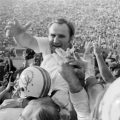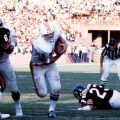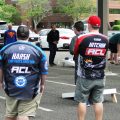Sports

Expanding His Roots – Jeff Holman, Haddonfield High Tennis
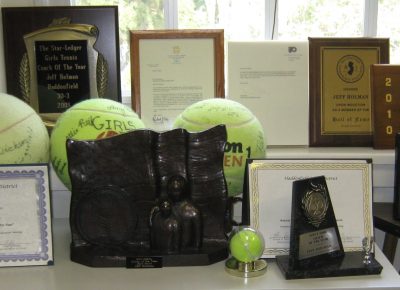
Jeff Holman is a member of the Holman family, a name you’ve heard if you’ve ever shopped for a car in South Jersey. But he’s made his mark coaching high school tennis, with over 2,000 victories to his credit. I interviewed him for the October 2013 issue of JerseyMan. You can view the PDF of this article here.
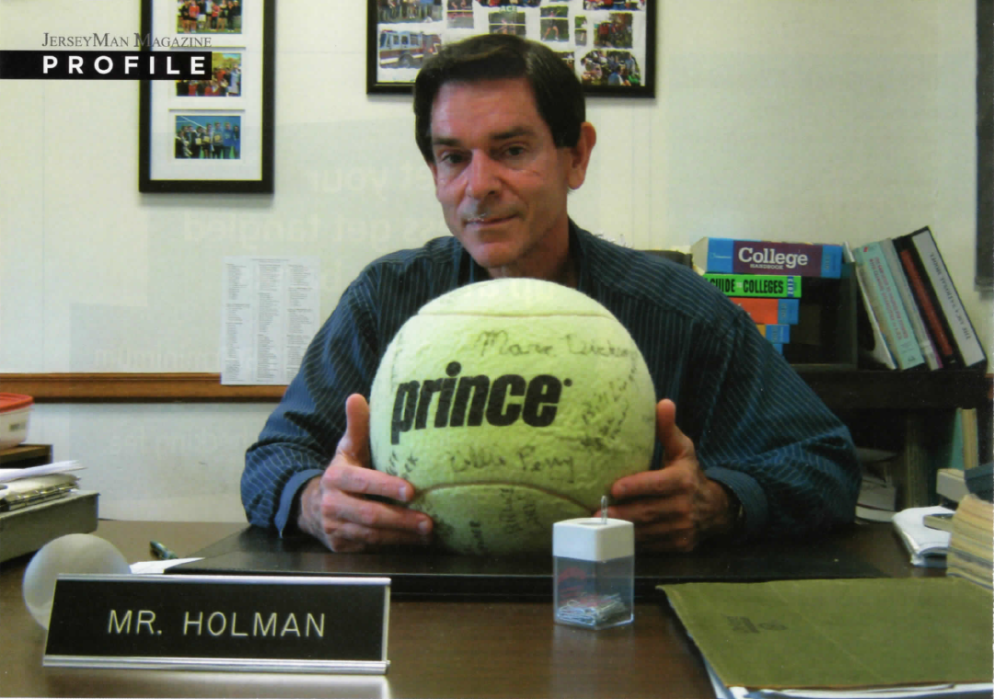
Jeff Holman, the legendary tennis coach at Haddonfield High.
Expanding His Roots
Jeff Holman is a member of the Holman car sales family, but he’s made his own mark in high school tennis coaching.
Mention the name “Holman” to a South Jersey native and chances are a car dealership will come to mind. The name has been selling automobiles in the Garden State for nearly as long as automobiles have existed. Most readers of this publication have probably either bought a car from a Holman or know someone who has.
But over the last three and a half decades, Jeff Holman has achieved what could be called legendary status in a realm that has nothing to do with Cadillacs.
By the time you read this article, Holman, who coaches both girls and boys tennis at Haddonfield High School, will likely have passed an astonishing 2,000 victories—both teams are within striking distance of 1,000 wins each. The boys’ teams have won nine state group championships; the girls’ team has won 18 state group titles and three Tournament of Championship crowns—often against larger schools with bigger talent pools.
He’s gotten quite a bit of recognition himself; 20 Coach of the Year awards, and membership in five Halls of Fame, including Camden County Athletics and the New Jersey High School Hall of Fame, are a small sampling of the countless awards and honors he’s received.
As successful as the family is in car sales, Jeff has proven that the Holmans aren’t a one-trick pony.
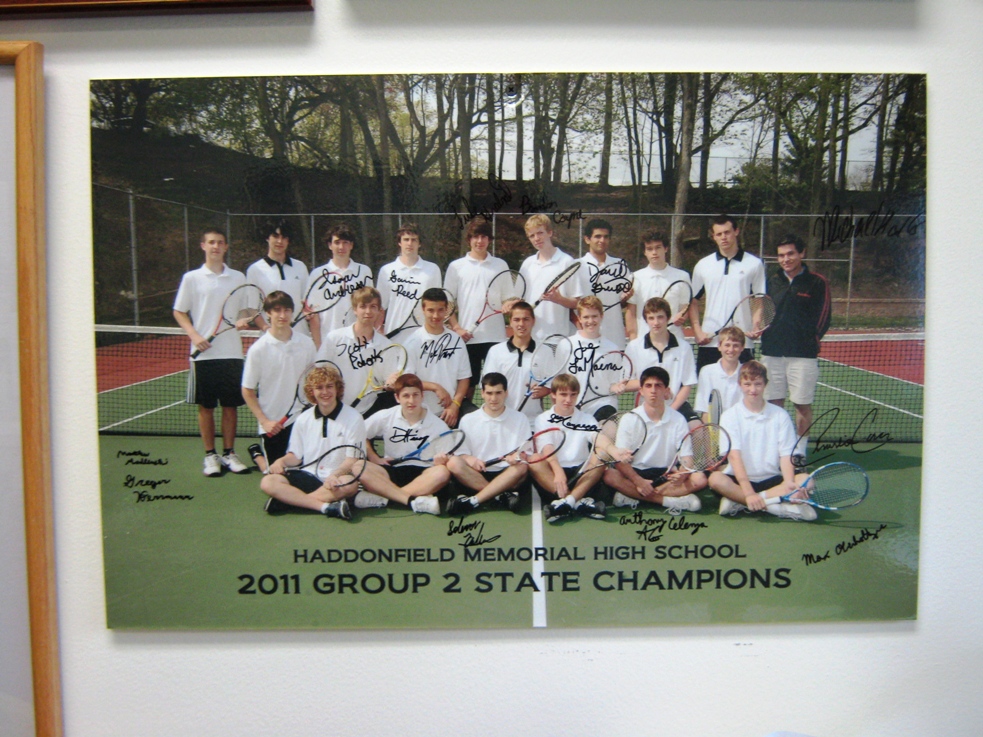
The Group 2 2011 Champions.
As a young lad, Holman probably thought he would sell cars when he grew up. He once wrote a “future career” paper on being a car dealer, which given his background was probably an easy assignment. But he says no undue expectations were placed on him by his Jersey famous family.
“I have two siblings; my sister Mindy is now the CEO of Holman Enterprises, and my brother Steve is a cabinet maker in Dorset, Vermont. Mostly, my parents encouraged me to do what I wanted to do. I had good teachers that encouraged me to get into education.”
Holman was a decent player at Haddonfield High, known for not rushing the net and simply wearing opponents down. But he knew he wasn’t destined for stardom on the court either. He attended college at Princeton, where the talent was, to put it mildly, substantial.
“The #1 varsity player at Princeton (Bill Colson) was ranked ahead of Jimmy Connors. My roommate was a two time Nebraska state champion; he wasn’t even a consistent starter. I was realistic enough, a good high school player, but I never thought I could play professionally.”
After graduating from Princeton, Holman returned to Haddonfield as an English teacher, and served as an assistant coach on the girls’ basketball team. Haddonfield being a small school, there weren’t enough tennis courts for two teams, so the girls’ season was moved to the fall in 1976. Their coach, Ellie Kind, was also the field hockey coach, so Holman took over the tennis team when the two schedules merged.
Two years later, Ken Grabert, the boys’ coach, “decided that driving the bus to events paid more than coaching, which was correct”, and Holman took over the boys’ team. 35 years later, though he’s now a guidance counselor, he is still on the court with young people most afternoons, steadily adding to the impressive win totals and titles.
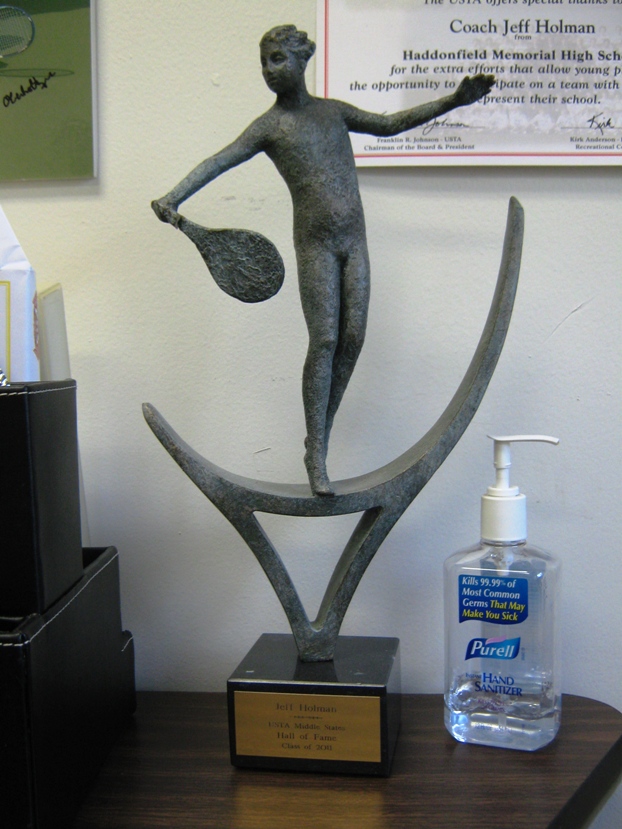
One of many awards found in Jeff Holman’s office.
Leaders in any endeavor will often tell you that success depends on choosing the right personnel. In high school sports, this presents a significant obstacle. Coaches don’t have the option of recruiting the best players from a 500-mile radius. The kids in town are what they’ve got.
In this environment, Holman magnanimously gives some credit for his success to local tennis clubs as a place where parents teach the game to kids. But he also piled another challenge on top of recruitment limitations: a no-cut rule. Every student who signs up will have a chance to represent Haddonfield tennis. Jeff explains the reasoning:
“One of the best players I ever had was a girl named Phoebe Figland, she was part of the 1980 team that won the first ever Tournament of Champions. Back then we had four courts, I had to keep 16 girls, and Phoebe as a freshman was number 17 so I had to cut her. Luckily she wasn’t one of those kids that gets discouraged easily; she came back and earned a starting varsity position, and went on to become a Division I player at the University of Richmond.
“Maybe in Phoebe’s case it gave her more inspiration to become as good as she did. But I think other people might have quit. Since that time I’ve always looked for a way to keep everyone involved and not cut people.”
That means arranging more matches with more teams, which Holman does. “In our program we have 40-50 players, and schools we play against may have 10-15. So by having a lot of matches and a separate rotation system, even though our team is bigger, all of the players get to play in matches. If they are all involved and can have a fun experience and see improvement, they’ll want to keep on playing and getting better.”
If you’re looking to ferret out a nugget from him about how to successfully coach high school sports, that is mostly what Holman will tell you. Keep all the kids involved, having fun, and playing tough competition. Encouragement and positive reinforcement. Not much about fundamentals.
“The mechanics, a lot of that is learned in the offseason. It’s hard to change someone’s mechanics during the season. They might get worse before they get better. There are outstanding professionals in the area that our students have gone to, and these teachers have instilled some mechanical knowledge of the game.”
So instead of teaching backhands or “getting into the zone”, Holman’s focus is on arranging as many matches as he can with quality opponents, and separating practices into groups so that all of the players get time in with the coach.
He even drives the team bus. It’s a gesture that appears to be a show of humility or bonding, but it is actually rooted in practicality: “If the school doesn’t have to pay a driver, then tennis, which has no transportation costs, enables Haddonfield to play an ambitious schedule. We can go to North Jersey or I can schedule more matches in a week. In this era of budget constraints, not having to play a bus driver really frees up our program.”
Whatever it takes. “I think it’s important to convey that this team is very important to me and I’m going to work harder than anyone else. And that whatever I ask the players to do, I’m going to do the same thing or more in terms of commitment.”
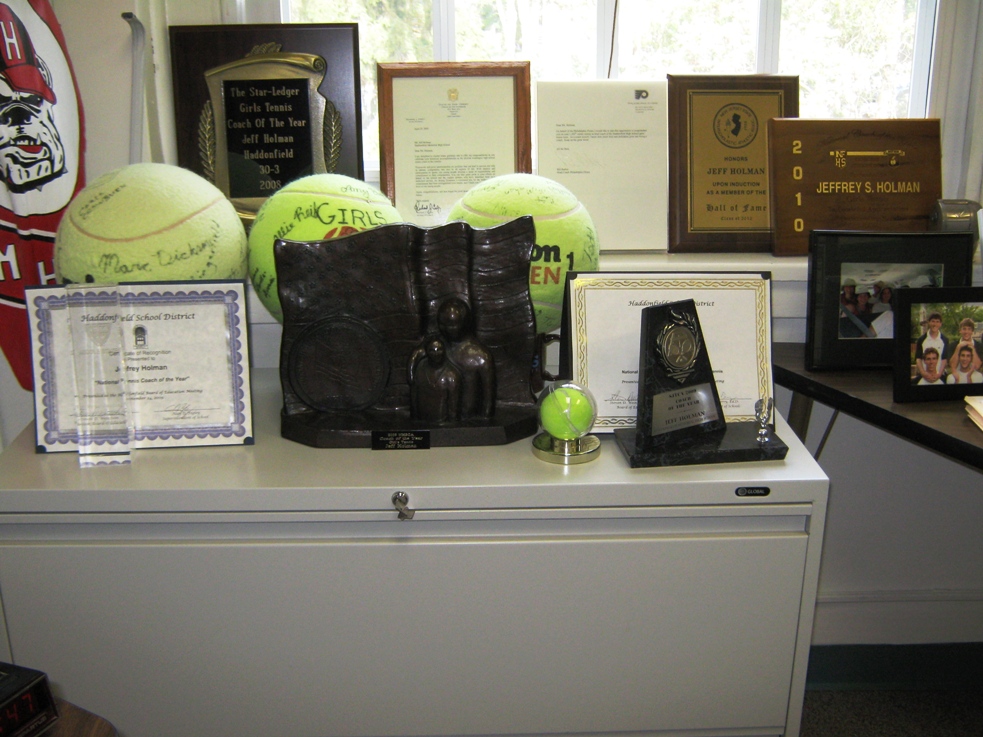
So many awards it almost blocks the window.
Holman’s proudest achievement? After coaching 70-plus seasons, he has trouble picking a favorite memory. “I guess when you do something the first time it stands out. On the girls’ side I think back to a team in 1980, the first year New Jersey held the Tournament of Champions, when the state champions of all the different divisions have a playoff. The 1980 team won that initial tournament. The boys kept falling short in state tournaments; finally in 1983 that group of players was the first Haddonfield team that won a state title.
“Haddonfield has always been a very successful athletic school at everything, but there have only been a couple of teams that have won a Tournament of Champions. The girls’ tennis team has done it three times now. It’s a very rare achievement.”
Holman tempers any appearance of boasting. “It’s nice to win championships, and we’ve done our share of that, but above all we’re trying to instill a love of the sport, and in their later lives they are still playing, and that maybe part of the reason was the Haddonfield program.”
One of the winningest high school sports coaches in the country seems reluctant to suggest that what he does results in more than young people enjoying the game of tennis. But he’s undoubtedly played a role in the character building of many young people. To teach them that they will have a chance to get in the game, to play against the best, and to be able to challenge opponents with unfair advantages and still win, undoubtedly leaves a stamp of confidence on an adolescent mind where self-esteem can often be in short supply.
Especially for a kid that might not have otherwise made a team of 16.
Jeff Holman doesn’t have an apparent personality for car sales. He is a soft spoken, even-keeled fellow, highly regarded by all who know him, but there is still a cauldron of quiet determination in him. If it weren’t for Haddonfield’s reputation as a high school tennis powerhouse, you wouldn’t expect this quiet gentleman to bring a team from a small school that can whip your big school’s behind.
And for several generations of Haddonfield tennis playing alumni, the Holman name means something more than an established place to buy a nice automobile.

The Old Ball Game – SJ Men’s Senior Baseball League
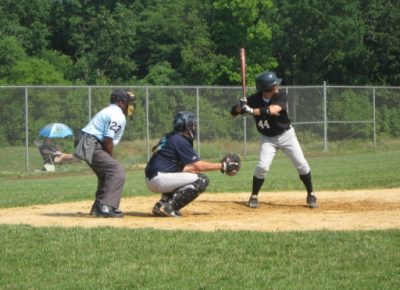
The South Jersey Men’s Senior Baseball League is a haven for men in their advanced years who still can and want to play some baseball. I wrote this piece for the August 2012 issue of JerseyMan; you can view the PDF from the magazine here.
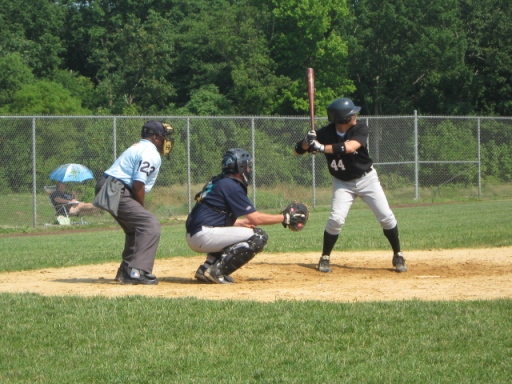
Waiting on the high hard one, adjusting for everything else.
The Old Ball Game
After 20 years, the South Jersey Men’s Senior Baseball League is stronger than ever.
On a picture-perfect Sunday morning at Doc Cramer Field in Manahawkin, the Hammonton Black Sox are playing hooky from church to play baseball, in a time-honored tradition that a Benevolent Supreme Being isn’t likely to mind.
With his team shorthanded, manager Mike Dunleavy must take the field and has enough to keep him busy, so he lets this observer keep score in their game against the Ocean Pirates. At one point a Sox player slaps a weak chop that travels about ten feet but successfully moves the runner on first over to second. There is a dispute over whether it counts as a sacrifice. “You’d be surprised at how much these guys look at their stats,” Dunleavy tells a writer who, as a former softball player, is sure he wouldn’t be surprised at all.
The team has several batters hitting over .400, but they’ve managed little offense in this game. “Junkballers,” the manager says, of his hitters’ performance against the Pirates’ Jeff Martin. “We always have trouble with them.”
In the bottom of the ninth, he calls a conference on the mound with his pitcher Tom King, to figure out how to pitch the Pirates’ Eddie Titley with a runner on second and the game tied. Over King’s objections, Dunleavy orders Titley to be put on intentionally. King, who has pitched a fine game, walks the next two batters, and the Pirates take a 3-2 victory over the Black Sox with two runs in the ninth. Despite its painful obviousness, the manager feels compelled to point it out: “Tough loss.”
Following the game there is a brief shouting match in the dugout between Dunleavy and King over the decision to walk Titley, which is fairly quickly smoothed over. It’s not a contract year, after all.
“From eight to eighty, the game is the same,” Dunleavy says. “It’s still about pitching and defense. There’s nothing I can tell these guys that they don’t already know.”
And so it goes in the senior fast pitch baseball world.
Dunleavy has managed Hammonton’s team in the 45+ American Division for seven years. When his team is shorthanded he will take the field, and occasionally he takes the mound to pitch. At his advanced age, he isn’t stealing bases or hitting bombs or overpowering hitters, but like most pitchers he can still pitch a successful game if he keeps the ball down. The Pirates, he says, are their friendly arch rivals—the Black Sox had lost to them two years before in the championship game, and had beaten them last year for the championship. It’s not Yankees-Red Sox, but it still fires up both teams.

Taking the field in Camden for the All-Star contest.
On July 15 of this year, the South Jersey Men’s Senior Baseball League celebrated its 20th anniversary at Campbell’s Field in Camden. In a brief on-field ceremony, league president Lou Marshall and vice president Neil Hourahan presented league founder Bill Curzie with a plaque, as a thank you for being the indefatigable spark for the SJMSBL and a key ingredient of the glue that has held the league together for 20 years. Whether it is attributable to the league’s success is not certain, but Curzie does not appear to have aged at all in two decades, and at 77 still looks fit enough to play two.
In 1992, at the age of 57, Curzie met up with players of a Pennsylvania division of the MSBL, and asked about setting up a fast pitch baseball league in South Jersey, which had none at the time. National league president Steve Sigler enthusiastically gave Curzie permission, and off he went.
With the help of a story in the Burlington County Times—that began with the words “Curzie is serious”—Curzie spread the word quickly. It turned out that South Jersey was heavily populated with thirty-, forty-, fifty- and even sixty-somethings who still wanted to play ball—and didn’t mind faster pitches or nine innings, the way the game was meant to be played. In less time than it takes a superstar free agent to say “it’s not about the money”, there were enough players for four teams, and the league began with six.
With the help of Curzie’s equally dedicated assistant commissioner Gary Brown, the SJMSBL kept growing, and is now the second largest senior fast pitch league in the nation, with over 1,200 players in four age brackets. There’s been a 25% growth in the 18-year-old group, which bodes well for the long term health of the league. They are adding a 55+ division next season.
Curzie shares the story of his standing firm on the league moving to wooden bats, after the national disgrace of aluminum bats had been the norm for some years in nearly every league. Today, most fast pitch leagues are back to using wooden bats, and Curzie humbly accepts some of the credit for that. When asked the ridiculous question of why wooden bats over aluminum, he has a simple response: “It’s just baseball, man!” He does elaborate further, though. With the reflexes of players at this age, aluminum bats are more dangerous, and besides, there are too many cheap hits with aluminum.
Today Marshall and Hourahan now handle the running of the league. The list of administrative tasks is long. In the beginning of the season, Marshall must be in continuous contact with the national headquarters of the MSBL, ensure that fees are collected, manage schedule changes, work with the umpires’ organization, deal with the inevitable problems that teams will have with the schedule, and arrange the All-Star weekend in Camden.
It’s a lot of work maintaining the league and playing on top of it—a full time job, Marshall admits. It’s all worth it, of course. He echoes the sentiment of the players on the field: “you feel like you’re eight again.”
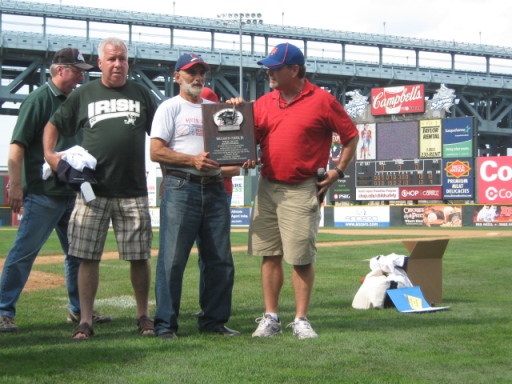
Bill Curzie accepts an award for putting players back on the field again.
There aren’t hot dogs, exploding scoreboards or the roar of the crowds. You won’t see players at the level of Andrew McCutchen or Mark Teixeira here. But you might appreciate, as these fellows do, how difficult it really is to throw out a baserunner attempting to steal or to turn a double play. Dunleavy says, “Hunter Pence can throw out a guy at third base. We would need a couple of extra throws to get the ball there.”
Perhaps, but that’s an exaggeration that doesn’t give credit to the skills many of these fellows have.
They wear uniforms and cleats. They steal bases. They take advantage of fundamental mistakes. They throw the ball around the horn after a strikeout. They use leg braces and pine tar. Balks and infield flies are called. There are rundowns, pickoffs, and lots of spitting. There is pressure to win, real trophies, and real statistics displayed online that people from here to Cambodia can see.
Some players even look for that little bit of rule-bending edge. Marshall tells the story of a pitcher loading a ball with tobacco juice and snot; eventually he even bought a container of K-Y at the store with his wife present—assuring her it was for his “other slider”.
Being an umpire, which pays in the neighborhood of $80 a game, is just as thankless a job as it is at any level of baseball. Players gripe about calls throughout the game, which the ump, who wants to appear professional just as the players do, mostly takes in stride. Between innings an umpire shares stories about rare times where he’s ejected players. One involved a thrown bat making a loud clang; another involved foul language directed at him. But most times, he says, if he’s got to be out in the heat, then so do they.
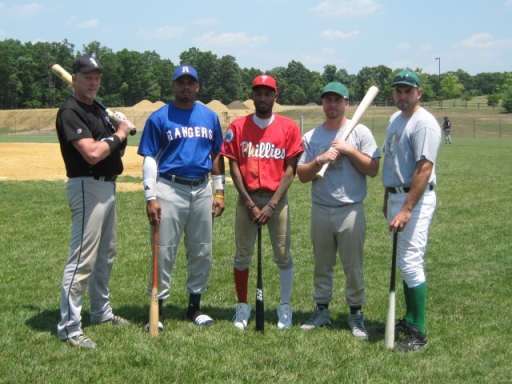
Stars of the league.
The SJMSBL is a haven for men refusing to age—who desire to compete on the highest level they can, relive the playing days of their youth, and many times to do both.
Anyone can sign up and play. It’s a time commitment; players give up a day of their week, in this case a Sunday morning. They’ll need legs too; they’re going to be running the full 90 feet between the bases. Some of them will get hurt in battle; many of the Black Sox’s best are currently on the DL. During the interview, Marshall—who still plays while running the league—shows me elbow scabs from sliding.
Never once does it occur to any of them that none of the games will be on television, that they won’t be driving a Porsche with their contract, or that it’s highly unlikely anyone besides an insurance company will ask for their signature. They are playing a boy’s game again, and loving every second of it. Who wouldn’t leave it all on the field?
Dunleavy remarks: “I have seen in the faces of the older guys what men’s senior baseball has done for their spirit. They never thought that they would ever get the chance to actually suit up and play competitively again.”
From eight to eighty, the love of the game is the same too.

Sons of Philly – The Philadelphia Union
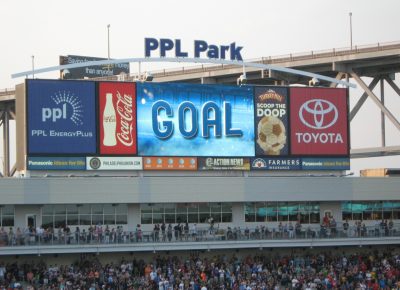
When the Philadelphia Union were a relatively new Major League Soccer team, JerseyMan sent me to interview their then-CEO Nick Sakiewicz. I took some time to talk with members of their fan club too. Fun piece to write, and they gave me tickets and press passes! This article was featured in the August 2014 issue of JerseyMan. You can view the PDF of the magazine article here.

The Sons of Ben, at the River End of then-PPL Park.
Sons of Philly
In their fifth season, the Philadelphia Union have an established fan base, a fan club as dedicated as any in sports, a beautiful venue, and what appears to be a very bright future.
From the moment of the opening kickoff, the chanting begins.
A couple of thousand fans, in the aptly named River End section of PPL Park, are shouting and singing, with drums pounding continuously. Their energetic intonations change themes frequently, but they continue almost nonstop throughout the evening.
Their enthusiasm is palpable, giving the impression that the River End is unquestionably the place to be to enjoy a soccer match. The rest of the 18,000 here tonight are almost subdued by comparison, as if they are witnessing an entirely different event.
This isn’t to say the other fans are apathetic, of course…it is Philadelphia after all, and any sports team that performs well will be warmly received, as the Union players are when they launch three goals in the Colorado Rapids net.
But for anyone present at a Philadelphia Union game, it’s clear that it takes a special kind of fan to sit at the River End with the Sons of Ben.

A capacity crowd at the Union match.
Despite a disappointing first half of the 2014 campaign, the Union are playing to 98% capacity crowds in their shiny new venue.
PPL Park, located in Chester, is an open-air facility designed exclusively for soccer. It is neatly planted along the Delaware River waterfront, with many of the seats affording a striking view of the Commodore Barry Bridge. With 18,500 seats, it’s large enough to feel major league, yet small enough that no seat is too far removed from the action. Fans in the furthest seats can admire the professional footwork of the players.
Philadelphia was near the top of the list of cities targeted for teams when Major League Soccer was founded in 1993. But the insufficient venue became a problem. Veterans Stadium, home of the ill-fated Atoms and Fury teams of the 1970s, caused MLS to look elsewhere at the time.
Current Union CEO Nick Sakiewicz, who was in on the founding meetings, tells the story:
“It was in an office in L.A., we had a whiteboard, and we were deciding which cities we were going to put teams in. Philly was in the top five. We’re starting a league, where do you need to be? L.A., New York, Philly, Chicago, Boston.
“The reason Philly never made it to the original ten was because of Veterans Stadium. It was a poor stadium, headed toward the wrecking ball, the Linc wasn’t coming anytime soon, and we had to start the league in 1996.
“We couldn’t come to a good solution where we felt the team would be hugely successful out of the gate, so we ended up going to D.C.
“The Metro Stars team that I managed, we played in Giants Stadium, 86,000 seats, we averaged 20,000 a game. Not even half full, lousy field, American football stripes, fans would come and say, ‘this isn’t serious.’”
So one of the nation’s biggest markets was not represented until MLS became popular enough to expand…into cities like Toronto, San Jose, Houston, and finally, Seattle and Philadelphia.
Once MLS began to expand, just in case they needed any encouragement to come to Philly, the Sons of Ben were there to help.

You know you’re a fan when you haul a big-ass bass drum to a match.
The Sons of Ben were founded by Bryan James and Andrew Dillon in 2007, solely for the purpose of bringing a major league soccer team to Philadelphia. They are named for Ben Franklin, arguably history’s most notable Philadelphian. As member Tim Sosar accurately puts it, “He helped found a nation, just as we helped found a soccer club.”
In a few short months, two tireless guys became over 650 fans toiling for the love of soccer and a city. They lobbied MLS for a team and local politicians for a venue. Scarves, flags and shirts bearing logos were designed, petitions attracted thousands of signatures, and pledges of season ticket sales were sent.
But the SoBs’ most notable statement came in their bus trips to matches in New York and D.C., where they sometimes numbered in the hundreds—and made their presence known as only Philly fans can.
Along with repeated chants of “Philadelphia!”, in New York they bleated at the Metro Stars: “We’ve won as many cups as you!” In D.C. for an MLS Cup Final, the SoBs bellowed “Buffalo Bills!” while sitting among fans of the frequent bridesmaid New England Revolution…a jeer that resulted in projectiles being thrown at them by enraged Revolution fans.
New England lost the match. Philadelphia won a soccer team.
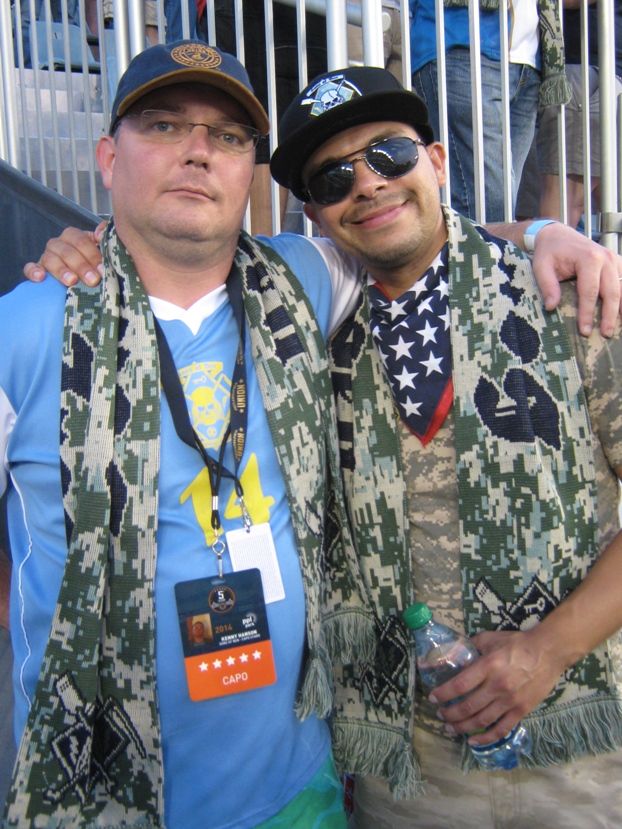
Kenny Hanson (left), the then-president of the Sons of Ben.
Kenny Hanson, current president of the Sons of Ben, is unequivocal. “The Union is here because of the Sons of Ben. Otherwise there would not be a team here.” Sakiewicz doesn’t disagree, calling their contribution “massive”.
“They were influential in our logo design, their colors, the snake that’s in our logo is from that focus group. And how the culture emerged. The DNA of the Sons of Ben is in the DNA of the Union.”
Indeed, Sakiewicz—a proud, dues-paying member himself—was so impressed with the fervor of the SoBs that he offered to buy them a beer for their effort when the team’s arrival was announced. It cost a bit more than he expected.
“I wasn’t sure how big the group was yet, because all of this was on the Internet. Is this three guys in a garage, is it 50 guys, or is it 100 guys? So I said screw it, what’s 50 or 100 beers? When I rolled up there were 800 people. Big American Express card bill.
“Worth every nickel. Best $6,000 I’ve spent.”
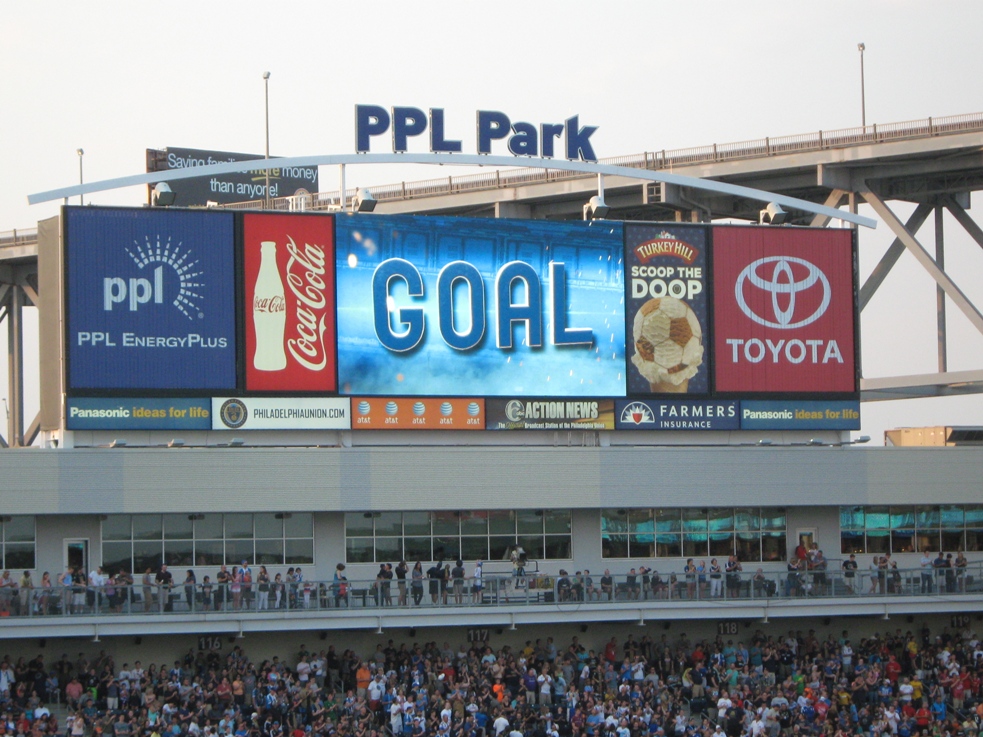
Be sure to say it with fifty “O”s.
Half a decade later, the Sons of Ben are now over 5,000 strong, and with the near sellouts at PPL Park, it would be hard for Philadelphia area natives to argue that American soccer…finally…is picking up steam.
Sakiewicz credits social media and generational bonding for the surge. And the USA’s performance in the World Cup helped.
“We used to have books to go to, the Millennials have this (holding smartphone). On this you can follow every league in the world, every player in the world.
“Did you see the heat map of Twitter? When Christiano Ronaldo scored the second goal for Portugal, which pretty much iced it for us, Twitter did this heat map, the whole country just lit up red. Great graphic on ESPN.
“On top of this, millions of them have been playing the game the last 30 years. The 80s kids are Sons of Ben members, and they aren’t kids anymore. They’re money making, money spending professionals who are having kids. The pipeline of soccer fans is beginning to age and come through generationally. Add into that foreign expats…big Spanish speaking foreign expats. Guess what their parents played and loved? Soccer.
“So now it’s an American sport. In Brazil right now, the largest percentage of tourists are Americans. Nearly 200,000. Biggest single nation that is visiting Brazil for the World Cup.”
Sakiewicz and the Union don’t plan to rest on their considerable success at the gate. PPL Park was built to expand, and they will when the time is right, he says. But the first matter on the front office minds is turning the Union into a title contender, starting with finding a team manager.
“I’m sitting on over 200 resumes from around the world,” Sakiewicz notes. “There are some big names interested in coaching this team. Which is frankly very surprising to me, and maybe it shouldn’t be. With the exposure the league’s getting, games are more prevalent in Europe and South America. They see the quality of the league, what’s going on, the World Cup with America doing so well.
“Anyone who’s been in this for 30 years, like I have, shouldn’t be saying, ‘Well, how did we get so good?’ 20 years of MLS, brick by brick by brick. And bang, all of a sudden Tim Howard’s on Good Morning America.”
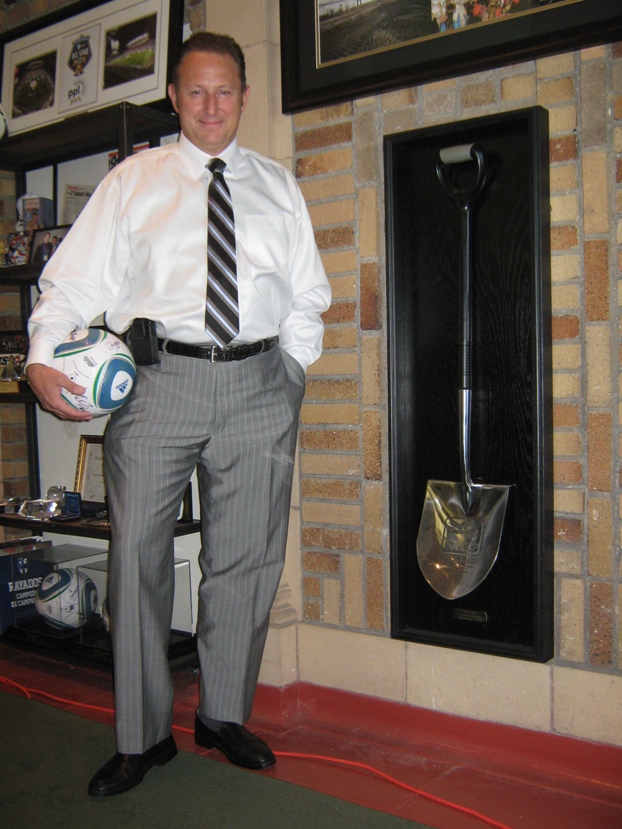
Nick Sakiewicz, the proud CEO of the Philadelphia Union, in 2014.
A native of Passaic, Sakiewicz is most proud of those around him who have been a part of this thriving sports enterprise in the City of Brotherly Love.
“If all of this went away, and I was down to my American Express card and me, give me the same people and we’ll do it all over again. I’ve managed three other clubs, launched the league with the founding executives, and that was all fun. But what this project has been about is much more near and dear to my heart, because first of all I own a piece of it, which helps. But also, I fell in love with this area and the city of Philadelphia and the people.”
Sakiewicz adds an apparent contradiction that he is confident every Philly fan will understand.
“It’s a hard place, but it’s also a soft place.”
“It’s a passionate place. I’m not throwing stones at New York, but I get it now. I’m a Philadelphia guy. It’s a really great place to operate—if you know how to be a Philadelphian.”
A skill that anyone can learn, should they need help, from the Sons of Ben.
Note from Kurt: Kenny Hanson, the president of the Sons of Ben at the time of this article, sadly passed away in 2017. You can read this article about the reaction to the tragedy. It was a great pleasure to meet with Kenny and speak with him. He was a funny guy. R.I.P. Kenny.

The Life of A Jockey – Jose Ferrer

Being a jockey is tough work. You have to stay in shape, find work where you can, and win enough to keep getting hired. JerseyMan sent me to interview Jose Ferrer, who spent the day riding a couple of horses to victory at Monmouth Park. You can read the PDF of the article here.

Jockey Jose Ferrer, on Fiesta Rose shortly before a win.
Taking The Reins
A day in the life of a jockey.
It’s Opening Day at the Monmouth Park racetrack.
It is cloudy, almost foggy, and unseasonably cool for May. But the chill is of no consequence to those in attendance. When it comes to Jersey weather, “unseasonably” is an adjective that most residents laugh at anyway, and so turnout is still high.
The picnic areas of the venerable venue are full of dining patrons awaiting the next race. Some have brought sandwiches, others partake of pizza or hot dogs at the concession stands. The odor of charcoal wafts from the private party areas. It’s mostly adults in attendance, but there are a few kids, who spend the day looking for ways to amuse themselves.
The infield scoreboard shows a replay of the tight matchup in the previous race, where Mello Groove edged Greed Is Good in a photo finish. Tractors smooth out the track for the next race. A truck pulls the gate along the surface to the starting line.
For the third event, jockey Jose Ferrer, who rode Greed Is Good previously, mounts Fiesta Rose, a three-year-old 9-5 shot. Periodically the announcer reminds the audience how much time they have left to place a wager. Finally after growing anticipation, especially for those with a financial interest in the outcome, the bell rings and eight very large animals begin sprinting out of the gate.
Fiesta Rose starts on the inside of the track and takes an early lead of about a length, which lasts until they turn into the far corner. Halfway through the race, the lead over The Slipper Fits becomes two and a half lengths, with Fiesta Rose gradually building on the lead.
As they round the final turn, it’s clear that this race will be no contest. Over the last hundred yards, Ferrer and his faithful steed have pulled away from the field. Ferrer methodically and rhythmically cracks the whip the rest of the way, just enough to keep the galloping animal honest.
It’s an easy win for Ferrer, and he rides to the winner’s circle with the confident smile of a man who’s been there before. He tosses the whip to a fan with a satisfied flair, raises his arm in triumph, and hops off of Fiesta Rose. He pats his mount affectionately, and starts back to prepare for the next race of the 12-race card. Along the way, he pauses to shake hands with some happy and newly richer fans and to pose for photos with his family.
Ferrer will race several more times on this Opening Day, including piloting a 13-1 shot named Light’s Gone Wild to another nearly uncontested victory in the sixth event. Like with any great athletic feat, the best make it look so easy.
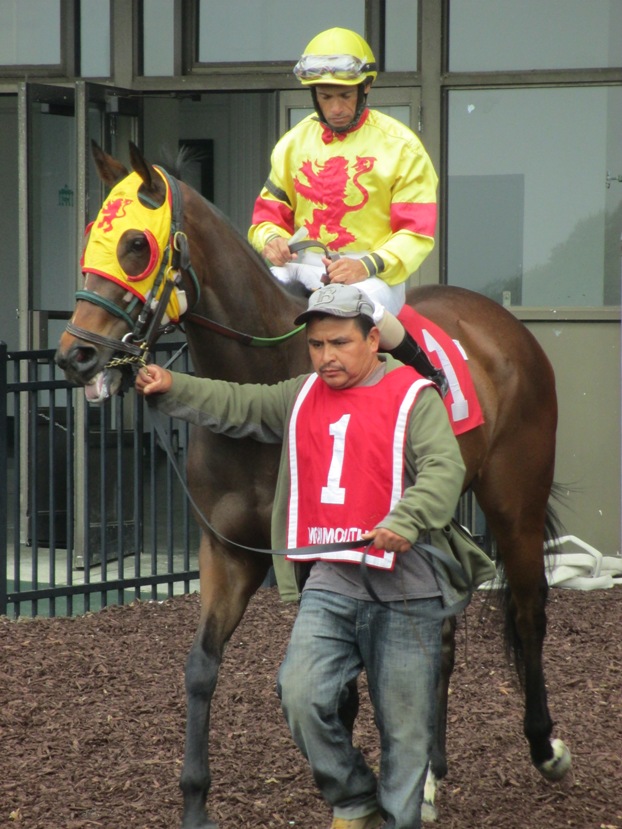
On Fiesta Rose pre-race: “You have to have the horse.”
“You have to have the horse,” Ferrer explains, modestly downplaying his skills. “You’re driving a Corvette, I’m driving a Volkswagen, who’s gonna win? I would say that it’s 85-90% horse, and 10-15% of it is jockey. It could be any kind of odds, 20-1, 40-1, you just need a horse.”
He speaks from experience, this veteran who has been riding horses now for 32 years. With an uncle and four cousins as riders in his family, the occupation is in his blood, and more importantly, he respects the challenge of making a living at it. Like the folks who wait in line to wager on the event, jockeys are rewarded for the horse’s finish. But the jockey has to work harder for it.
“It’s not easy, like people think. Some riders make a pretty good living, but you’ve got to get lucky. We get paid by mount, by horse. We don’t sign a contract, so we’ve gotta go there and compete against everybody. You’ve got to compete, you’ve gotta beat them. You do everything you can to bring the horse to the winner’s circle.”
Ferrer frequently compares the jockey’s life to that of other athletes. Like in other sports, the competition is fierce, the effort can be dangerous, and the best performers seem to have a natural gift.
But being a jockey has its own unique challenges, too. If you sometimes yearn for the blue collar days of athletes past, when even the best supported their families with championship bonuses, listen to Ferrer discuss the jockey’s world:
“If the card has twelve races, you could run twelve races, or you could run one, or two. It all depends on how much business you’ve got. We used to race like five or six days a week, now we race only three days a week. There are a lot of places, Parx, National, that on days off…we call Monday through Thursday days off…you can go ride over there.
“We don’t have a contract or anything; we’re like painters or plumbers. And it’s like any kind of business, if you get a good reputation, you do a pretty good job or whatever, people will call you. The more races you win, the more they want you. It’s about performance, how you perform out there. Any kind of thing could put you on the bench.
“But it’s a cool job, you get to meet a lot of people, it’s great to be on a big horse, it’s a big high, you know. It’s like hitting home runs, to see that you came first, your horse performed great. And if people win money, they’re happy with you, if they don’t they’ll boo you and call you names,” Ferrer says with a chuckle.
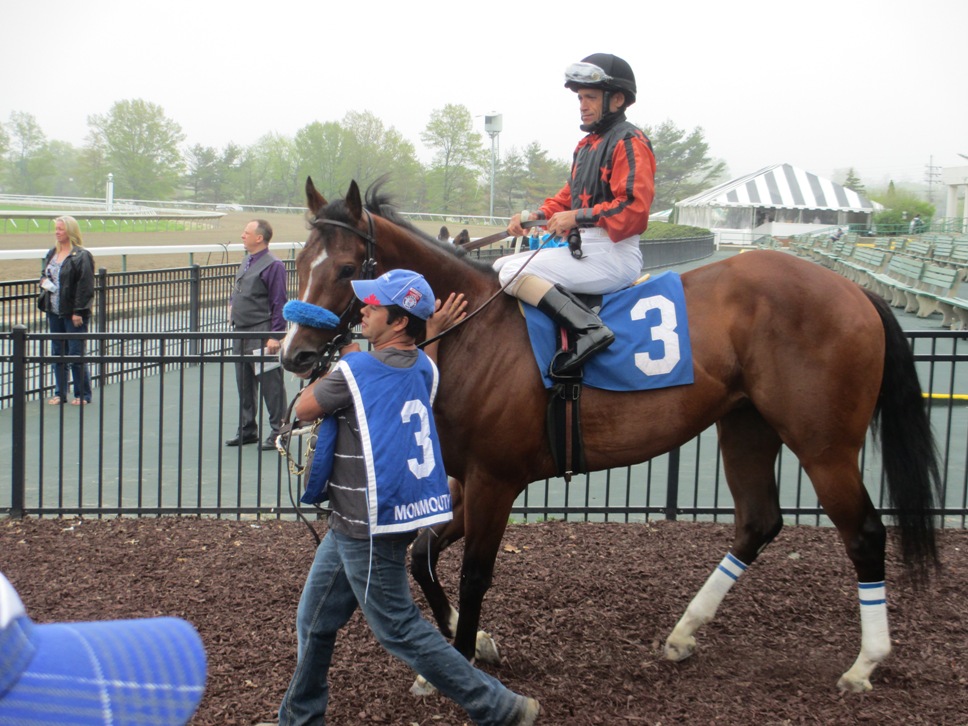
Ferrer on Light’s Gone Wild, another horse he would soon ride to a win.
Asked what makes a jockey skilled enough to be in such demand, Ferrer credits experience and preparation.
“Before the race you’ve got to study the horse. I try to have a good idea what’s gonna happen that race, and then figure out what our position is going to be. There’s a lot of things going on out there. You’ve got to feel the pace. If the horse comes from behind, you lay off. Some horses like to come from last, they break out of the gate and sit back, get comfortable gaining their strength, and then make a move. A lot of horses don’t like to be inside. So you break out of the gate, try to go through and work yourself out, and use the outside.
“I’ve been doing this for 30-something years, they might look the same, but they’re not. That’s why you go in the morning, that’s what we do in the morning, try to learn how this horse performs, how they like to run.”
It sounds simple in theory, but the execution takes skill and strength.
“You’re on top of a 1,500 pound animal, no brakes or nothing, just reins to hold him back from going forward. Anything can happen out there, they could do anything, stop, go here, jump.
“You have to be in top shape, absolutely. Because when you’re on the horse, you’re pretty much on your toes for that minute and a half, almost two minutes. You’ve got to have great balance, your knees have to be strong.”
It’s risky, too.
“You go down, anything could happen, you could break your neck, break all kinds of bones. If you get hurt at the track, they’ll pay you for being in the hospital, but when you come out, you’re on your own. It’s just one of the downfalls. I’ve gone down and had injuries, nothing bad.”
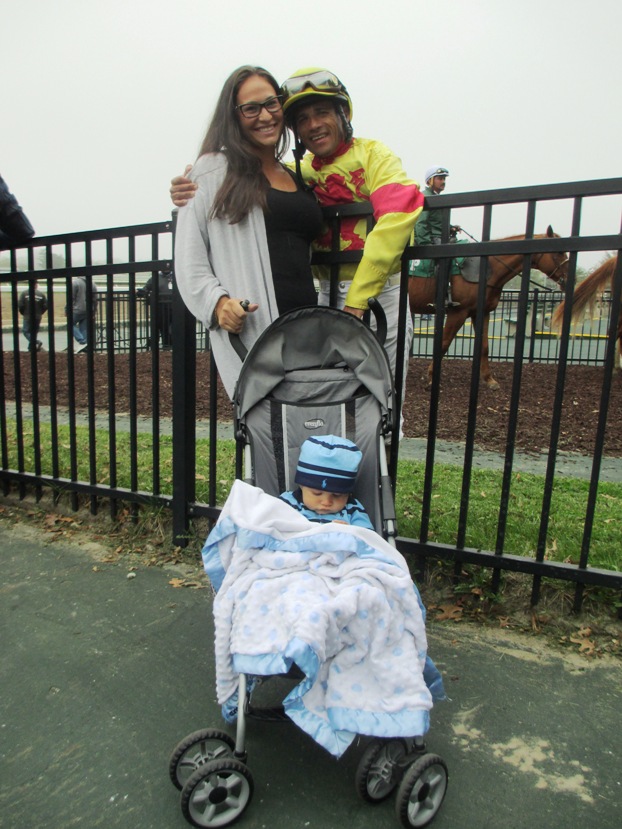
Celebrating a victory with the family.
While the job of riding fast horses is unquestionably as physically demanding as any athletic endeavor, the veteran Ferrer says that his profession does have one edge that keeps them going at it longer than most…that their results still depend on the abilities of the four-legged animal beneath them.
“Baseball player, 40 years old, you’re old. Football player, really old, because you’re depending on your body. But being a jockey, it’s 85% horse, so I’m thinking if I stay fit, I could ride wherever I want. If you’re still fit, you can do it for a long time.
“The challenge for riders when they get old is the weight, they don’t want to lose the weight and keep it down, and the older you get the heavier you get. Now that I’m a little bit older, I try to be in the best shape I can be. I lift a lot, I run a lot, and I do a lot of weights. I like to be strong.
“Why do players hit home runs? It’s a gift that God gave you. It’s about using that gift, some guys, they don’t use it.
“I’m proud of doing it for so long, staying consistent. You want to win big races, you want to win the Derby. But if you don’t have a chance, you move on. You keep doing what you’re doing. The man upstairs gave me a great family, a beautiful wife, that’s very important to me.”
And Ferrer already has career plans for his young son.
“I hope he’ll be a jockey or a baseball player. I love baseball.”

This jockey’s a pretty good bet.
The Ferrer Report
Jose Ferrer’s done alright at horse racing: 3,936 wins in 27,227 starts as of this writing (an average of almost a win in every seven starts), along with close to 7,000 place and show finishes as of this writing. His earnings over his 32-year career have totaled over $65 million, for an average of $2,400 per start.
He’s won a few big races, too: three Red Bank Stakes, two Miami Mile Breeder’s Cup Handicap races, the Iselin Handicap, the Jersey Shore Breeder’s Cup and the Matchmaker Stakes, to name a few. Ferrer is one of only five jockeys to have multiple Miami Mile wins, and is one of only three jockeys to have three or more Red Bank Stakes wins.
In 2015 thus far, Ferrer has 109 starts, and has already put 19 wins, 16 second place and 7 third place finishes on the board. His races have earned over $300,000 in winnings.

Derek Jeter’s 3,000th Hit – An Unlikely Witness, Part 3
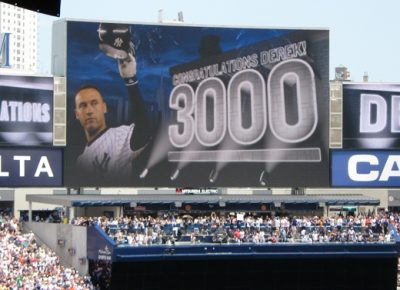
In Part 2 of this mini-series, yours truly shared how I managed to somehow secure a $30 ticket for the July 9 game at new Yankee Stadium, just hours before gametime, on a day with higher demand than many playoff games. As miraculous as it was, it turned out things weren’t so rosy after all.
After landing a ticket with what could only be described as ridiculous luck, Gary and I took a walk over to the nearby McDonald’s to meet up with both Michael Casiano (the King of Royalty Tours) and Gary’s cousin Andy, who was celebrating his birthday with a Yankees game.
We blended in with the pre-game crowd, buying water bottles and picking up sandwiches at the takeout restaurants. With the ticket quest apparently over, I could finally relax, and soak in the scene of hundreds of fans clad in Yankees gear and of outside vendors selling snacks and drinks.

Why DO you pay five dollars inside?
Ballpark E-Guides Tightwad Tip #5: Before Yankees games, there is (or used to be, anyway) a gentleman who sells very large and ice cold bottles of water on 161st Street east of the Stadium, for $1 each. You can’t miss him; listen for the “one-dollar ice cold water, one dollar water”, punctuated with a periodic “Why you pay five dollar inside!” It’s baseball at its best.
And yes, you can bring them into the Stadium (so long as they are sealed), and save mucho cash.
About an hour before the game, we head towards the ballpark, with Gary promising to take me through the Royalty entrance and avoid the mob scene at the gates. Having written the book on how to get around the Stadium, I knew about this, but in fact I’d forgotten about it.
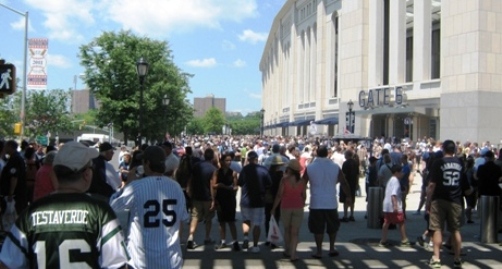
“Everybody form one line!”
We reach the double secret entrance, and sure enough there is no line at all. The Ticket Scanner Guy scans Gary’s and Andy’s tickets and sends them through. Then he scans mine.
Beep-beep-beep! Invalid barcode.
He tries again. Beep-beep-beep! Nope.
Scanner Guy looks at the ticket, and then shows me that it’s for the September 22 game, the makeup game for the Friday game that was rained out. Someone behind me shouts, “Oh boy, one of those guys!”
Scanner Guy tells me to take it back to the box office. Gary, witnessing this from the good side of the gate, has a look of distressed shock on his face. I tell him not to worry, even though I expect I’m probably really screwed now.
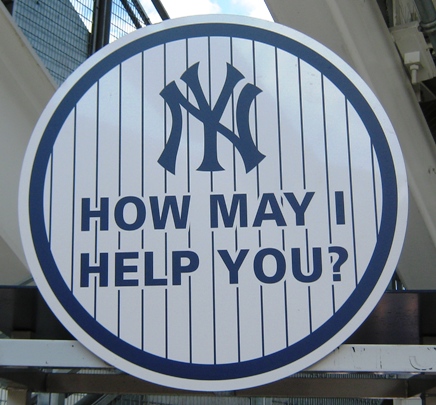
This calls for Divine Intervention.
Heading back to the box office, I’m asking for Divine Help now, because my company’s reputation could be on the line here. “God, I know there are bigger problems in the world, so it’s okay if I don’t make it inside. But any help from up there would really be appreciated!”
I arrive at the ticket agent’s window and explain. I deliberately am as nice as can be, knowing that this was just a mistake.
The ticket agent already knows, apologizes and gives me a refund. I somehow work up the nerve to ask if there is anything now. The ticket agent punches it up, and amazingly, finds another standing room ticket, this time on the lower level, for $60. I hand over my credit card.
And then, in a moment of chutzpah that I am not often known for, I change my mind, ask for my credit card back, and request that the agent keep checking for something under my rigid $40 price. The agent promises to keep trying and asks me to wait against the wall.
Twenty minutes pass. On the television in the office, the starting lineups are announced. I can hear the crowd at the announcement of Jeter’s name. The national anthem is played.
I stand and wait, along with several others, wondering if they are in my boat and I’ll end up in a bidding war that I would surely lose. Other agents–who had previously been shouting that $375 tickets were all they had–begin to pull down the shades on their windows. The game is now absolutely, unquestionably, really, really Sold Out.
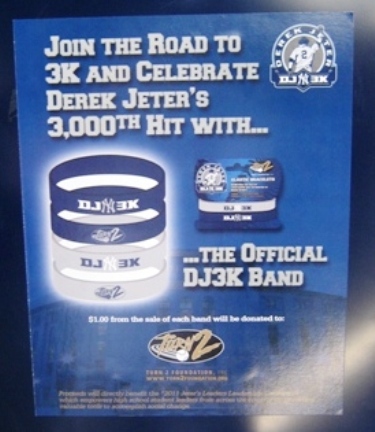
I hear the band is pretty good.
My agent gets up and walks away. I am actually worried now that this doesn’t cause the agent heart trouble, because I understand it was just a mistake and I knew going in that this was a very long shot.
Five more minutes pass. The agent returns and motions for me to come to the window.
“OK. I’ve got a standing room, field level on the third base side. Looks like someone just turned this in on StubHub.” I prepare for the price and wonder what I am going to do.
And the agent says: “No charge.”
I can’t believe it. “Really?” I nearly shriek. “Yeah”, the agent says. “I screwed up, and you’ve been really patient about it, so no charge.” I thank the agent profusely, and stick my hand as far as I can underneath the tray so he can give me five on my fingers, which gets a smile.
Ballpark E-Guides doesn’t deal in intangibles. An E-Guide isn’t going to tell you how to suck up to your boss or befriend someone you ordinarily wouldn’t because he has season tickets. But this is something I should share. If a ticket operator or agent makes a mistake, by all means try to stay cool and be as understanding as you can.

This lot is approximately a 16-mile walk from the Stadium. Hey, it’s New York.
Many New Yorkers might have loudly fumed obscenities at this agent, not because they are bad people but because they live in an expensive city filled with scam artists, and they often have to be on guard about being ripped off.
If you can manage to hold it together and not get upset, a person used to the opposite reaction may just go the extra mile for you. Or the extra ten miles.
I have done it again. Every single stupid, arrogant, unreasonable gamble has paid off. I head over to the nearest gate now, hearing that the game has begun. I scan the ticket at the turnstile.
Beep-beep-beep! Invalid barcode. I try again. Beep-beep-beep!
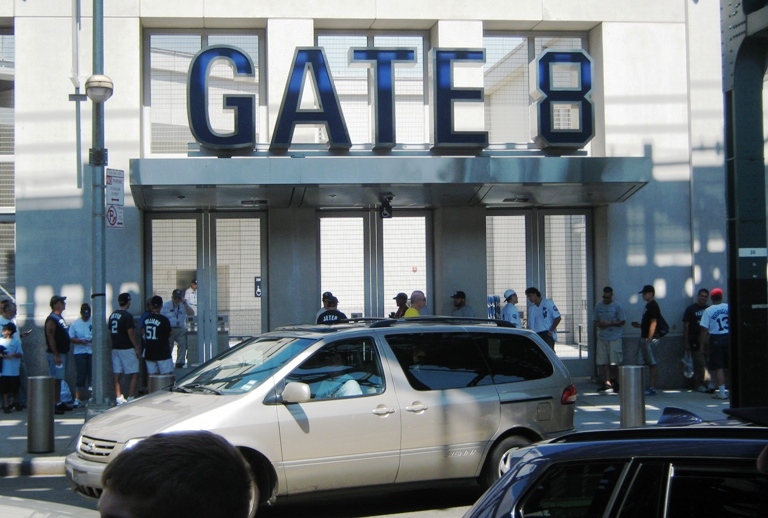
In case you’re wondering, no, this isn’t the secret gate that accepts invalid tickets.
The usher tells me to try at the next gate over, but given recent experience I know this won’t work. The ticket’s been used or something and the barcode has been voided. If there was any doubt before, there can’t be any left that I’m done now.
I head back to the agent’s window and explain what happened. The agent laughs in disbelief, takes the ticket and walks away.
Five more minutes pass. The agent returns and says “The ticket is still valid, it should be good, all I can tell you is try again.”
I walk over to the same gate again, and try to scan the ticket.
Beep-beep-beep! Denied.
Again, the usher tells me to try the next gate over. At this point, I have nothing to lose, and I move over one turnstile. Another usher looks at my ticket and says “this is standing room”. He scans the ticket with his handheld scanner. Beep!
“Go ahead.”
I float into Yankee Stadium, and make it to a standing room spot just in time to see Derek Jeter crack a base hit into left field for hit number 2,999, and share in the moment with delirious Yankees fans.
I found Gary later and shared the whole story. He was, as he said in his blog post about the day, impressed.
After all of this, it turns out I would be handed one more piece of good luck: it turns out Derek Jeter hits Tampa Bay pitching pretty well. He not only clouted a mammoth shot for his 3,000th hit on the first pitch of the next at-bat, he went 5-for-5…scoring number 3,001, 3,002, and 3,003—which turned out to be the game winner. I thought he might hit 4,000 that day.
Well done, Captain.
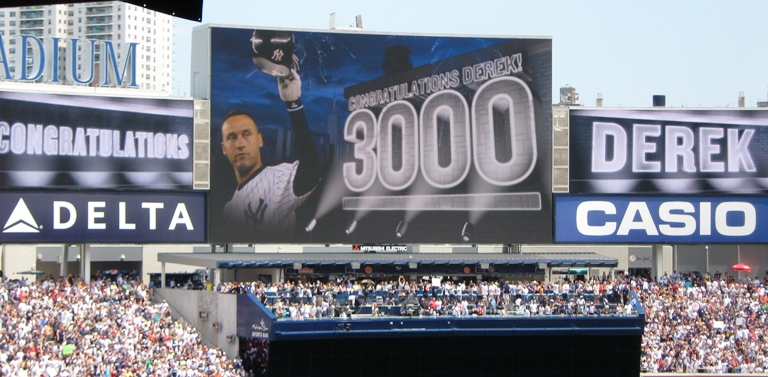
The only career Yankee with 3,000.
I went to New York City on July 9 with a modest goal: to demonstrate the money-saving benefits of a Yankee Stadium E-Guide to potential customers and hopefully gather some pictures and helpful tips. I came back to South Jersey someone overwhelmed by an astonishing lesson in faith, patience, and perseverance. Everything imaginable seemed to go wrong—and somehow turned out right.
If you had told me the night before, the hour before, or even the minute before I walked through the gate that I would not only make it inside Yankee Stadium on that day of all days, but that I would do so for free, I would have pronounced you certifiable. I still would. I still can’t believe it.
In the ninth inning, Mariano Rivera comes running in to Metallica’s “Enter Sandman”—another Hall of Famer, another great tradition—and shuts out the lights on the Tampa Bay Rays. Yankees win.

And Ol’ Blue Eyes’ voice booms through the PA singing “New York, New York”. As Sinatra sings, I suddenly realize that, for one day at least in New York City, I have Made It There.
Damn, I love baseball.

Derek Jeter’s 3,000th Hit – An Unlikely Witness, Part 2

Previously in this narrative, I shared the story of seeking cheap Yankees tickets online for Derek Jeter’s 3,000th-hit game at new Yankee Stadium, to no avail.
But despite my lack of success, I decided to get on the Boltbus to New York City and further push my luck. As documented, yours truly at least managed to get to New York City inexpensively, in no small part by avoiding parking at Yankee Stadium.

Get to NYC on a comfortable bus for four quarters…
But the larger problem of needing a ticket to enter remained.
Upon arriving in Manhattan, I decided to try Modell’s in Times Square. Modell’s and the Yankees have jointly found a way to unload some unsold seats, by offering them at half price on game day. (This tip is included in the Yankee Stadium E-Guide.) They are based on availability, however, meaning my chances of landing a ticket for under $40 were, of course, slim.
As I reached the ticket counter, someone was signing the credit card slip for tickets he had just bought. As soon as the transaction was completed, I asked the gentleman behind the counter, “What’s the most inexpensive ticket you’ve got?”
Before he could answer, the customer informed me: “One hundred and eighty-five dollars.”
Well, at least I got a picture.

I’m just here for the gear.
Yankee Stadium Tightwad Tip #3: The Modell’s in Times Square does indeed have Yankees tickets available on game day, even for prime games, but you will not often find the lower priced seats. But, if you do want the premium seats, there will probably still be plenty available, and at half of the extensive price. For that, Modell’s is worthwhile.
Plan C now. I took a walk over to 6th Avenue to board the D train, the weekend express train that flies north to the 161st St.-Yankee Stadium station. I exited the subway and there the gorgeous monument to baseball dynasty stood.
Already people were setting up shop…parking signs were being put up, hot dog carts were already peddling, and the beautiful hot morning already had the air of a day of baseball.
The first stop was at the game day window at Gate 4…or more correctly the line for the game day window, which stretched a good half a block to Jerome Avenue. Evaluating the situation, I decided that this was not worth the risk, and that there were other avenues that needed to be exhausted first. Which they would.

I’ll have the hot steam please.
By this point hunger was setting in, a condition inexpensively cured with a sandwich and a knish from the Court Deli, a couple of blocks east of the ballpark on 161st.
Somewhere around this time a new camera card became a necessity, and following the directions of some nice Bronx folks, I was able to locate a nearby Target and fix the problem, while finding some less expensive parking I hadn’t noticed before. All a plus, at least for my readers…
So while passing the time I took a photo-op at the 153rd Street-Yankee Stadium Metro-North Station, which was built along with the new Yankee Stadium to provide a rail option from northern suburbs. The new station is impressive, with a great view of the Stadium, and is just a short walk through Macombs Dam Park to the House That Jeter Built.
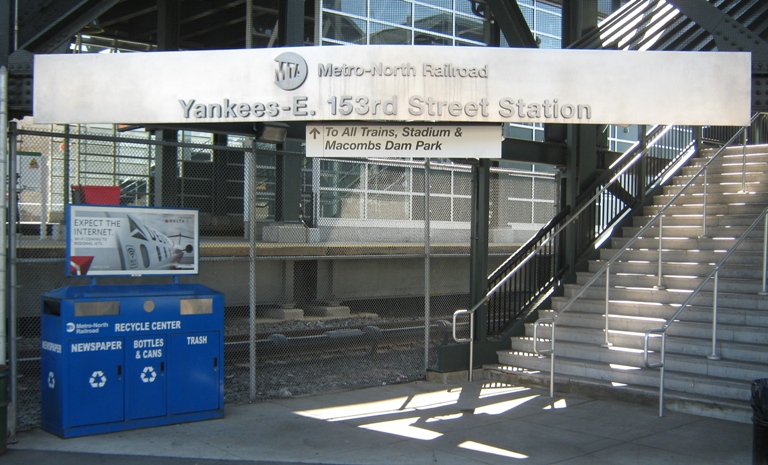
This sign probably cost about $1 million.
Unfortunately, fans had not yet started arriving on this route. I thought this might be my best chance to find unhardened suburbanites eager to rid themselves of extras, but found only a few folks headed to the game. Still early.
At the bottom of the platform exit stairs were two attractive women representing Stan’s, the nearby sports bar that is a favorite of ballgame goers. They handed me a card advertising their specials– $3.00 drafts during the 7th and 8th innings of the game. All well and good, I said (actually I think my exact words were “Woo-hoo!”), but does Stan’s have extra tickets?
The ladies wordlessly turned their heads in the direction of a scalper standing right there. Who, of course, seized on the opportunity to skin the vulnerable dreamer alive, showing me a ticket he just happened to have for sale.

More than one Happy Hour!
The correct date, a decent seat, and he made sure I recognized that this was a valid ticket. The face value was $45. “How much?”, I asked, solely to get a sense of the market.
“A buck and a quarter.”
For a second I was tempted to pull a dollar bill and a quarter out of my pocket, the same way Mel Gibson does in “Lethal Weapon”, acting like an incredibly stupid drug buyer. Instead I just chuckled and walked away over his loud objections: “How much were you expecting to pay?” “It’s only gonna be more closer to the stadium!”
Well, at least he was looking out for me. That was thoughtful of him.
Ballpark E-Guides Tightwad Tip #4: Try to find someone looking to get rid of extras before you patronize scalpers. Scalping is illegal in most states, so you shouldn’t be doing it anyway, but people with extras are far less likely to gouge you.
The scalpers in NYC especially are professionals, they do this every night, and they know exactly what they can get for a ticket from an eager fan. Someone with an extra usually just doesn’t want to eat it, so offer a fair price for it…don’t insult them. They may be doing you a big favor.
Now at least I knew where the market stood: three times above face value, and not likely to go down before the game started.
The next order of business was to do a lap around the Stadium, every so often shouting “anyone got an extra?” in as inoffensive a manner as I can manage to folks beginning to pour in. No luck. But I did find some free street parking nearby. (Shared in the E-Guide!)

Gary Herman has been to more Yankees games than I’ve been to games.
About this time I met up with my good friend Gary Herman, he of Royalty Tours USA. Gary has seen an average of 350 sporting events a year for many years now, and he documents his experiences on his blog, including sharing some helpful tips that have found their way into E-Guides.
If there’s a Guinness record for this kind of thing, Gary has to be a candidate, and most amazingly of all, he pulls all this off while working a full time job and not being independently wealthy.
By this time, somehow, the game day window crowd was separated from the exchange window, and now the line was down to only about 20 people. Gary stood with me in line, both of us knowing that it was a long shot for me to get a ticket. Gary promised me he could get a ticket for me next time if I need it. I didn’t doubt that.
I arrived at the window in short order, and asked the agent what the most inexpensive ticket was. Brief punching of keys on the computer. “I have a wheelchair seating ticket, on top of the batter’s eye in center field. One hundred and twenty-five dollars.”
Before I could begin working on Plan D, Gary taps on the window and pesters the agent a bit. “I just saw two kids leaving with 30-dollar tickets. You don’t have anything?”
The agent tries again. The clouds part. The sun shines through. Choirs sing. “OK, this just came up. Standing room, upper level in the left field corner. Thirty dollars.”

Check the date…check the date…
I am ecstatic. I gleefully hand over the credit card, take the ticket, sign the receipt, thank the agent profusely, and Gary and I leave the window and head for the food joints on 161st, ear-to-ear grin on my face. I’ve won.
Nothing could go wrong now…right?
Uh-oh…what’s with the ominous tone at the end of what should have been a triumphant victory for the tireless author of Ballpark E-Guides? Did Kurt get carsick? A hangnail? Second thoughts? What could have gone wrong?
Click here for the third and final episode of Kurt’s Derek Jeter Day Adventure!

Derek Jeter’s 3,000th Hit – An Unlikely Witness, Part 1

Some time ago I announced on my website that I was going to illustrate the benefits of a Ballpark E-Guide with the new Yankee Stadium Challenge…meaning finding cheap Yankees tickets, cheap Yankees parking (or other cheap means of arriving at the ballpark), or cheap food at the shiny and expensive new Yankee Stadium. No, I didn’t plan for that to be the day of Derek Jeter’s 3,000th hit.
Wait, what? Cheap at Yankee Stadium? Am I being serious? Yes, I am.
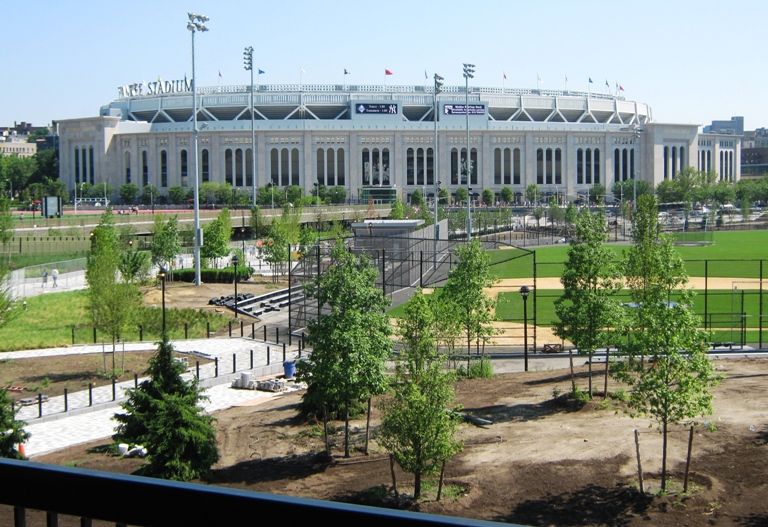
The new monument to lots of money.
As I stated, you don’t often hear the word “cheap” associated with anything baseball, Yankees or New York City. Most people groan at the thought of what it will cost them to see a game at baseball’s majestic home of the most successful team in North American sports history.
Yankees tickets can be over $1,500 for one game, parking at Yankee Stadium as of this writing is $35, and a beer will run a fan as much as $11. And that’s not counting having to drive on Turnpikes and to cross bridges that often require ridiculous tolls, if you’re coming from anywhere but inside the city limits.
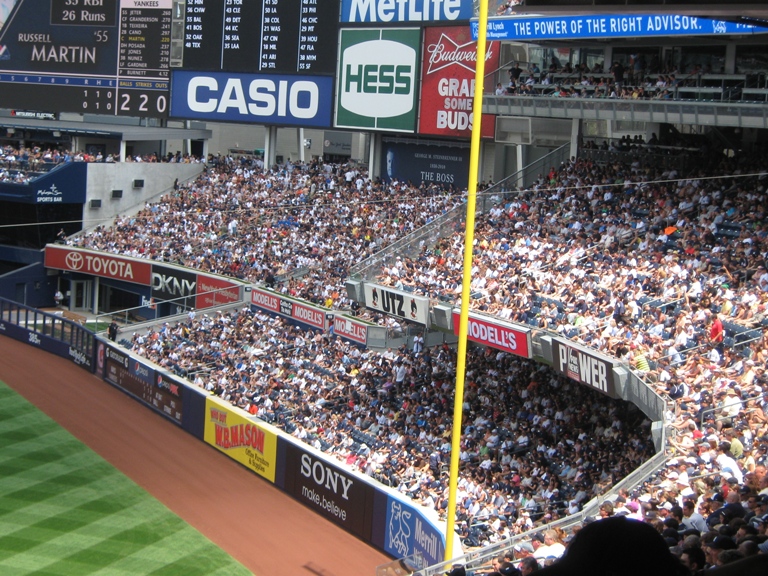
The extra shade away from the bleachers costs about $50.
Most fans just think they need to accept this or maybe think that it’s worth it to see the Yankees. For all of this supposed gouging, the seats and parking lots are still full, and there’s still lines at the concession stands.
But I decided to take on the challenge of seeing a Yankees game as cheaply as possible, using tips from the Yankee Stadium E-Guide and on the Ballpark E-Guides blog.
Little did I know what a challenge it would really turn out to be.
I picked the absolute worst game of the season to try this. The challenge was actually planned months ago. Sometime in April, July 10 became the date, which I then revised to July 9 for family matters.
And as you all know, on July 9, Derek Jeter clouted a home run to etch his name on the 3,000-hit list that day, the first Yankee to do so.
Folks, long story here, but it’s a great story, and it includes a lot of advice, so stay with it and I’ll try to make it worth your while.
A few days before the game, I had not yet bought a ticket, not having anticipated that the Captain would be returning to the lineup and closing in on history. Even so, I was following Ballpark Savvy’s advice, and waiting until just before game day to buy a ticket.
Generally this works fairly well; as game day approaches, the supply increases and the price usually comes down. But as stated in the E-Guide, you can’t count on this, for precisely this reason.
I decided $40 would be as high as I would go for a ticket. On Friday afternoon a ticket became available on StubHub for $41.
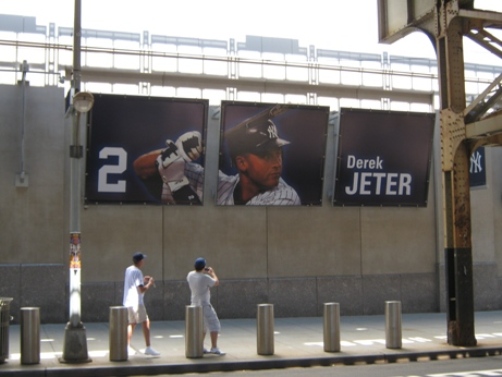
The last single-digit Yankees number.
I was encouraged by the drop, but refused to pull the trigger. Then, as I thought might happen, late in the afternoon people began coming home from work and buying, and tickets below $60 disappeared.
Then Friday night’s game was rained out and postponed, leaving Jeter stuck at 2,998 hits, and me now really in a bad way. Ticket prices for Saturday’s game soared. StubHub’s cheapest ticket was now $90 for standing room and even more for obstructed view, and would remain at that price all night.
Yankee Stadium Tightwad Tip #1: When using StubHub or other third-party broker, set a realistic low that you want to pay, and when you see something you can live with, grab it. For high-demand games, expect the price to rise in the evenings, when folks are home from work and online.
Well, okay. Here I am, ticketless. I’ll get back to that. But now let’s talk about actually getting to Yankee Stadium on the cheap, also no easy thing.
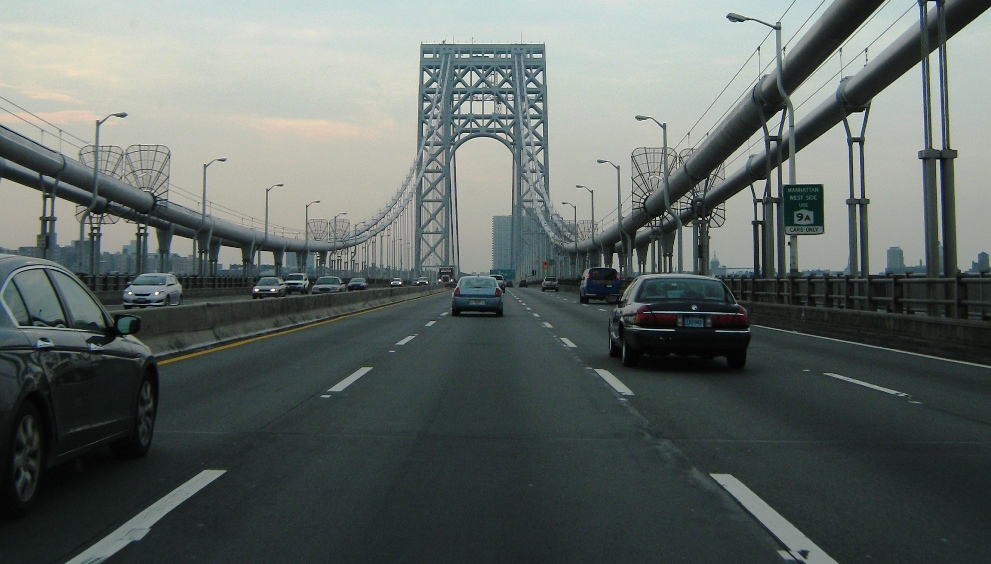
You won’t often see this few cars on this bridge. Must have been 5 AM.
If I were to drive straight to and park at Yankee Stadium, coming from South Jersey, I would have used I-295 to exit 7A of the New Jersey Turnpike, and then crossed the George Washington Bridge into the city. That route is, according to Mapquest, a 118-mile drive from my front door.
The bridge is $8 (free into NJ). Turnpike tolls total $12.50. Gas would be about $45, assuming no traffic…ha ha. Parking at Yankee Stadium is a whopping $35. That’s over $100 for round trip and parking.
So if I try taking the NJ Transit train from Hamilton to Penn Station, that at least takes out the absurd parking fee.
This is just a 50-mile ride, with no Turnpike tolls. Parking at Hamilton Station is $7, and the train to Penn Station is $30 round trip for an adult. From there the B or D train to the Stadium (or the E to the B/D, which is a free transfer) is $4.50 round trip. So with gas being about $19 now, that’s a total of just over $60. Much better.
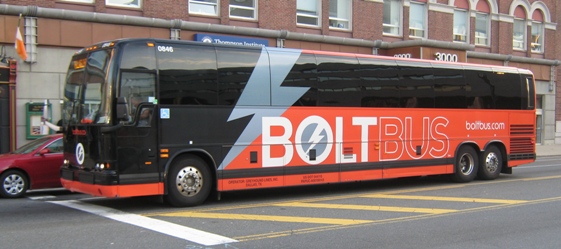
The Thunder Bus!
Fortunately there are cheaper bus options, most notably Megabus and Boltbus.
Both services offer great fare prices to get from one big city to another; Megabus is a bit cheaper and has a wider reach, but for some reason Yelpers seem to think Boltbus is better about service. I can’t say, but I do know that I saw two Megabuses show up while waiting for the Boltbus, so they can’t be that bad.
The Boltbus I used was $23 round trip, including the booking fee. Add to that about $7 for gas getting to a train station in New Jersey, and $7 for the round trip train ride that took me to the bus stop. Then the $4.50 for the E-D train brings the total to about $42…not much more than parking at Yankee Stadium, and less than half what the original plan would have cost.
Believe it or not, people do pay twice what they need to.
Yankee Stadium Tightwad Tip #2: If you’re coming to New York City (or Chicago, Philadelphia, Boston, etc.) from out of town and you’re close to another metropolis, by all means look into Megabus or Boltbus. The savings are large, and it’s not a bad ride at all.
Now, obviously this wouldn’t work as well for more than one person; if you want other options for getting to the game, there are plenty in the Yankee Stadium E-Guide. You can save money bringing others, too.
So of course now you’re thinking, Kurt, this is all fine and well, but what good is getting there cheaply if you don’t have a ticket for the game?
Stay tuned.
Did our hero make it inside Yankee Stadium? Was he able to witness in person a first in Yankees history? Did he finally cave in to reality and go deeply into debt for a once-in-a-lifetime experience?
Click here for Part 2 of Kurt’s Amazing Yankee Stadium Story!
The Curse of The UPS Car
While I was providing thoughtful NASCAR commentary for the Frontstretch, I noticed an interesting phenomenon about UPS-sponsored cars…that drivers either suffered significant decline with the UPS logo their car, or improved dramatically after it was gone. I detailed the whole curious anomaly in the article below, which first appeared on the Frontstretch in September of 2009.
Occasionally you hear comical stories of superstition in motorsports.
Joe Weatherly, whose untimely death in a crash is why stock cars have window nets today, suffered from triskaidekaphobia and once asked NASCAR to call the 13th Southern 500 the “12th Renewal of the Southern 500”. He also once asked to rename his 13th starting position in a race to “12a”.
There are green car phobias, which supposedly traces back to one of the Chevrolet brothers, Gaston, being killed in a Beverly Hills race. Gaston was driving a green car at the time and green has ever since been seen as bad luck, despite Bobby Labonte’s 2000 championship in an Interstate Batteries car.
Junior Johnson and Dale Earnhardt Sr. were both famous for their aversion to peanuts in the garage, and both were the targets of peanut-related practical jokes by team members and fellow competitors. One story told by Robert Yates describes a Johnson crew member painting foam packing peanuts and pretending to eat them near Johnson’s car, which sent Junior through the roof. “He didn’t think that was very funny”, chuckled Yates.
But who knows? Kevin Harvick claimed to lose an engine on a day where there were peanuts around the garage. Sometimes these things do take a life of their own.
With David Ragan pulling the UPS #6 into the Loudon garage after finishing 33rd and 13 laps down, placing him currently 30th in the standings, it’s nearly been forgotten that Ragan was seen as a driver with a bright future not very long ago, when AAA was sponsoring the car.
And it seems that there is some sort of whammy on any car that sports the famous UPS logo. Not anything dangerous, just something that makes racecars slow.
If your racing fan days go back a stretch, you remember how dominant Dale Jarrett once was, as difficult as that may be to believe seeing his last few seasons.
In 1996, Jarrett took over the Quality Car Ford Motor Credit No. 88 for Yates Racing. In that car he won two Daytona 500s, a Coca-Cola 600, and the Winston Cup championship in 1999, after falling 14 points short to Jeff Gordon in 1997. He won 20 races, scored 95 top fives, and 119 top tens in 167 races. That is rare supremacy in this sport.
Then Jarrett and Yates signed on with UPS, launching the now-famous “Race The Truck” campaign. For two years there was a slight downturn: six wins, 22 top fives and 37 top tens, and a fifth and ninth place finish in the standings. That’s hardly terrible in any two seasons, but it was the first noticeable decline in the performance of the No. 88.
Then in 2003, Jarrett fell off a cliff and never fully recovered. He won just one race and that win was his only top five in a season where Jarrett inexplicably finished 27th in points. For the rest of his career at Yates, Jarrett would score only one more win in three seasons and never again finished higher than 15th in the standings.
Despite the drop-off, UPS was happy enough with Jarrett as their spokesman to go along with him to Michael Waltrip Racing in 2007. In retrospect that seems like a giant blunder, but at the time most of the pundits saw the big name sponsors and manufacturer and the veteran’s three car team and predicted big things.
It didn’t work out that way. Jarrett burned his six champion provisionals very early in the season and made just 24 races in 2007, never once finishing in the top ten. At the end of the season, Jarrett finally tired of the aero disadvantages of racing in a parcel delivery truck and announced his retirement after five races in 2008. In those five races his highest finish was a 16th at Daytona.
The UPS hex then fell on David Reutimann. After a 2007 season where Reutimann was the top performer at MWR, Reutimann scored just four top tens in 2008, finally exhausting UPS’s patience despite their own role in driver declines. He still had the best results at MWR, but that wasn’t saying much.
After UPS left, with the much faster Aaron’s logo back on his car, Reutimann not only won his first ever Cup race at Charlotte, but he surprised everyone by challenging for a Chase spot well into the season. Reutimann has scored five top fives in 2009, after managing zero with the heavy UPS logo on the car. As I wrote this, he was also ahead of Dale Earnhardt Jr. and Kevin Harvick in the standings, two drivers that had little trouble acquiring sponsors in their careers. And 13 drivers separated him and the UPS driver.
UPS signed on with David Ragan starting in the 2009 season. In 2008 Ragan, with AAA on the car, seemed to have the best future of the younger drivers. He barely missed the Chase and finished 13th in points, a great improvement over finishing 23rd in 2007. He scored six top fives and 14 top tens in 2008 after scoring two top fives and three top tens in 2007. He had even scored 11th and 13th place finishes at Martinsville, a place where he had once been called a “dart without feathers” by Tony Stewart. Of course it seemed like a wise choice, if you didn’t consider the withering effect that UPS brown had on past drivers.
With the UPS logo on his car, Ragan went from riches to rags. The No. 6 has exactly one top ten this season, in the rain-shortened Daytona 500. Since then Ragan has finished in the top 15 just four times, never higher than 12th. His last three races have been three straight 33rds.
And he is 30th in the standings—if he drops one more position, it will be the same margin of decline that Jarrett suffered from 2002 to 2003.
It may be a strange statistic to look at, but what would be the odds of two different drivers, driving for two different teams, dropping 18 positions in the standings in one season while sharing only a sponsor in common? (And a manufacturer, I suppose, but many more drivers have driven Fords than have for UPS.)
Most all of this can probably be explained away without superstition. Yates in general was beginning a decline when they signed on with UPS. All of Michael Waltrip’s teams have struggled mightily. Roush Fenway has had problems with NASCAR no longer allowing them to test. You could just call it poor timing and foresight on UPS’s part.
But there isn’t any denying a noticeable correlation between a team’s performance with and without a brown UPS logo on a racecar. UPS appeared on Dale Jarrett’s car and he went from contending for titles to fighting to make races every week in just a few years. They appeared on David Reutimann’s car and Reutimann showed little improvement, then after their departure he rocketed to near playoff contention. UPS attached its logo to David Ragan’s car and he has gone from a young driver with a bright future to being one of those drivers who is rarely shown on TV unless he crashes or enters the pits backwards.
No doubt Matt Kenseth breathed a sigh of relief when UPS refused to replace DeWalt on the No. 17.
Did this post make your day a little bit?
I hope so. If it did, I would really appreciate your support.
When you use this link to shop on Amazon, you’ll help subsidize this great website…at no extra charge to you.
Thanks very much…come back soon!
Photo credit: rmkoske on VisualHunt / CC BY-SA
Photo credit: Darryl W. Moran Photography on VisualHunt / CC BY-ND
Photo credit: Dei3Nascar8 on Visual hunt / CC BY
Photo credit: The Freewheeling Daredevil on VisualHunt.com / CC BY
Photo credit: Hans J E on VisualHunt.com / CC BY-SA
Photo credit: pocketwiley on Visualhunt.com / CC BY
What Caused The Decline of NASCAR? A Former Reporter’s Thoughts
In the early 2000s, NASCAR was soaring. It may be difficult for younger people to imagine it, but the sport was once poised to overtake the NFL in popularity. Yes, that’s actually true; read it again if you need to. So what caused the decline of NASCAR to the point where the sport is desperately trying to remain relevant?
I covered NASCAR for six seasons for two excellent racing websites, That’s Racin’ (the Charlotte Observer’s racing site) and the Frontstretch. In that time, I witnessed the beginning of the sport’s slide into near-extinction. I’m also someone who became a disenchanted former fan myself.
Having followed the sport in the time frame when it began, I can offer what I believe are the real reasons for the decline of NASCAR. I can also dispute other reasons for it that I see being offered today. This is all just ultimately my opinion, but it’s a carefully considered one.
I’ll start with a few things that I don’t believe caused the decline of NASCAR, then I’ll share what I think really did.
The Decline of NASCAR, Non-Reason #1: The Cars Are Too Spec
I’ll submit that this is a reason a few fans I know stopped watching the sport. In NASCAR’s pre-1990s heyday, when it was still very much a regional sport, manufacturer identity was a big thing. People rooted for car brands as well as drivers, and car companies believed in the whole “win on Sunday, sell on Monday” mantra.
However, by the time NASCAR was peaking in the early 2000s, there already wasn’t much manufacturer identity left. The cars already were mostly spec at that point, and the sport was doing just fine…booming even. The decline of NASCAR from dominance started circa 2005, and there wasn’t any big change to car specs in that time period.
All that said, the unveiling of the “Car of Tomorrow” in 2007 certainly didn’t help. It was boxy, ugly, and top heavy…and its shape was part of the reason for the Indianapolis debacle of 2008. In that race, caution flags were flown almost every ten laps for tire wear, as Jimmie Johnson limped to a victory. The fan backlash was loud and intense. If any single event hastened the decline of NASCAR, it was Indy 2008.
But in a relatively short time, NASCAR corrected the car and the multiple issues with its design, and while the cars don’t differ by manufacturer like they once did, at least we’re not seeing disastrously awful races just because of the car’s construction. In fact, the current car lends itself to some pretty good racing.
Lack of manufacturer identity may have been a reason some hardcore fans left the sport in the early 1990s, but that doesn’t seem to me to be a valid reason for the sport’s popularity plunge since 2005.
The Decline of NASCAR, Non-Reason #2: It’s Gotten Too Safe
I’m not sure why people would think this, although I’d actually had some heated debates with Tom Bowles at the Frontstretch about it. Bowlesy thinks there needs to be an element of risk for racing to be exciting; I don’t tune in to races to see a car potentially fly into a catch fence and injure spectators.
NASCAR did (and still does) market the possibility of spectacular wrecks. I’ll never forget seeing Elliott Sadler’s terrifying end-over-end crash at Talladega in 2003 – and seeing it again in every single ad for Talladega races for the next 3-4 years. Maybe there is a segment of fans who tune in for death-defying calamities, but that has always been a part of the sport and still is.
I can’t imagine any fan of Dale Earnhardt Sr.…and there were a lot of them…not wanting to see the sport take every measure it could to keep drivers safe after Daytona 2001. This isn’t to say that the initial Car of Tomorrow wasn’t a disaster…it was…but at the time, fans were plenty vocal about safety after the loss of the sport’s biggest icon.
For any fan that needs racing to be dangerous, there are still four restrictor plate races on the schedule. But plate racing still sucks…not only do plates produce multi-car crashes every event, they pervert the standings because of it.
I’m not buying the “it’s too safe” bit as a cause for the decline of NASCAR. Racing is still pretty danged dangerous. Just because no one has been killed at the Cup level since Earnhardt’s death doesn’t make it less so.
The Decline of NASCAR, Possible Reason #1: Jimmie Johnson’s Winning
Jimmie Johnson was a hallmark of ruthless efficiency in his prime, winning seven titles and five in a row. With his brilliant head wrench Chad Knaus on the pit box, the #48 team for years remorselessly laid the field to waste when playoff time started.
Jimmie won a lot. Which meant that other drivers didn’t win a lot. If that contributed to NASCAR’s decline, however, that is on NASCAR.
NASCAR possessed one of the greatest dynasties in the history of sports during Jimmie’s reign. Yet instead of focusing their marketing on Johnson’s unequaled supremacy, NASCAR chose to put all of their marketing eggs into the Danica Patrick basket, believing a swimsuit model who could drive a racecar would save the sport.
Danica turned out to be a huge bust…as many people who followed the sport closely, including yours truly, predicted she would be. (It wasn’t a tough call to make, if you actually looked at her results instead of her figure.)
Dynasties like Johnson’s aren’t bad for a sport…unless the sport doesn’t know how to market them. The Yankees were always good for baseball. Tiger Woods was great for golf. The Patriots’ domination was great for the NFL. People love a winner, they love to hate a winner, and they love to see a dynasty get taken down. The #48 team should have been a gold mine.
So no, Johnson’s domination wasn’t directly a factor in the decline of NASCAR – but their failure to market it most definitely was.
The Decline of NASCAR, Possible Reason #2: Dale Earnhardt Jr.’s Losing
By virtue of his father’s untimely passing, Dale Earnhardt Jr. instantly found himself with a larger fan base than any three drivers in NASCAR. As the son of one of the greatest racecar drivers in history, Junior also had an impossible standard to live up to.
But for whatever reason, Junior not only didn’t measure up to his father’s formidable reputation, he rarely even established himself as a contender. Much like Kyle Petty, he ultimately became more known for his good-guy personality and his lineage than for his achievements on the racetrack. As Junior’s fortunes continued to trend downward even while driving for the strongest team in the sport, his fan base became turned off. And he had a very large fan base.
It could be argued that Junior was the sport’s last link to its tobacco-chewing, Southern past; once Jeff Gordon tore up the sport, drivers started to appear from every corner of the country. But the sport’s most dedicated fans were (and are) still in the Southeast, and Southerners are loyal to the core to their heritage.
It’s possible that the most popular driver not performing well hurt the sport, given the sport’s fan demographic. However, like Johnson’s dominance, I doubt that this would have been as much of a problem were it not for other factors that were far more damaging.
So here are three actual reasons for the decline of NASCAR. Still with me? OK, here we go.
The Decline of NASCAR, Actual Reason #1: The Chase
One of Brian France’s very first acts as CEO of NASCAR sealed his doom as a respectable heir to a business, and nothing he did for the rest of his tenure would change that perception.
I don’t often see NASCAR’s ill-conceived playoff idea as a reason people cite for the decline of NASCAR in articles I read these days, but I promise you, that was not the case when I covered the sport. NASCAR’s initial playoff brainchild was hugely unpopular, and every griping fan in comment sections of blogs everywhere had the artificial points reset near the top of their list of complaints.
It’s not so much that the points reset NASCAR introduced in 2004 was a monumentally stupid idea. It was, but even that wasn’t the point. It was the insistent implementation of it over loud objections of fans. NASCAR polled fans about the idea on their website following the 2003 season, and fans overwhelmingly rejected it. They shut down the polls and went ahead with it anyway.
If you want to attribute the decline of NASCAR to arrogant leadership, look no further than that single act. It was blatant condescension towards what was arguably the most loyal fanbase in sports. Why poll the fans if you’re just going to ignore them?
That and it really was a stupid idea.
In case you weren’t there or don’t remember, in 2004 NASCAR welcomed their new series sponsor, Nextel (now Sprint), with a new “playoff” system called the “Chase”. After 26 of 36 races, the top ten drivers would have their points reset, putting them all on a level playing field again for the last ten races.
Yes, NASCAR actually believed an artificial points reset after two thirds of the season was the move that was going to catapult them past the NFL.
Making matters worse, within four years, the driver with the second largest fan base finished with the most points in a season twice, only to lose the title to a points reset.
It’s not often noticed, but it was definitely noticed by Jeff Gordon fans: had NASCAR not implemented the Chase, the driver of the iconic #24 could have been the one standing aside Dale Earnhardt and Richard Petty today with seven titles, instead of his protégé Jimmie Johnson. Gordon scored the most points overall of any driver in 2004, 2007, and 2014. Nothing against Jimmie Johnson for winning titles with the rules as written, but he only managed that feat twice.
Gordon wasn’t the only driver who turned in a spectacular season-long performance only to have it nullified. In 2008 Kyle Busch smoked the field for the first 26 races, winning eight of them and setting the NASCAR world on fire with his brash and unapologetic racing style. After two DNFs in the first two Chase events resulting from simple bad luck, just like that his title hopes were gone. I was critical of the Chase in plenty of columns, but I felt like I really got the point across with this one about it.
It’s largely forgotten now, because the sport’s current elimination format playoff system at least had some thought put into it. It rewards winning, which rewards fighting for wins, which creates rivalries.
But the initial “Chase”, an artificial and contrived points reset, was despised by fans. It was a radical change to a sport that didn’t need radical changes. You could say it was NASCAR’s New Coke, except Coca-Cola was smart enough to change the formula back in response to furious customer backlash.
If they hadn’t, you’d probably be reading articles today about the decline of Coca-Cola too.
The Decline of NASCAR, Actual Reason #2: The Broadcasts
I don’t need to tell anyone who was a fan in the 2000s this, but NASCAR’s broadcasts at the time may have been the worst in the history of sports. Fox Sports’s coverage was particularly abominable, with a seemingly endless parade of commercial interruptions mixed with the Ford Cutaway Car, the Home Depot Pit Crew Member, the Viagra Boner Of The Race, whatever, all during green flag racing.
Mike Joy is an outstanding announcer, and it was never a big deal for a fan to mute Darrell Waltrip’s exponentially annoying “boogity boogity boogity!” at the green flag. But it was a never ending source of irritation to see five laps of racing followed by a several minute commercial break, which was then followed by another minute of a wide angle shot of the venue and “This race is being brought to you by <several companies who also paid an obscene amount of money to NASCAR>.”
There were often times…and I’m not exaggerating this…when a viewer would see maybe five laps of racing, a two-minute break, and then just two more laps of racing before another break. Anyone who was watching then could tell you that wasn’t unusual at all.
This was a problem that actually needed to be addressed and wasn’t. NASCAR blew off fan demand for picture-in-picture commercial breaks…something they’ve since embraced…while Fox Sports’s indifference to fans went completely unchecked. It was another case of costly arrogance; as much as fans loved NASCAR, they didn’t love it enough to put up with an endlessly saturated marketing campaign featuring occasional snippets of racing each week.
One shining example was a 2010 Dover race…a “playoff” race, no less…where ESPN broke away with 11 laps to go in a very much undecided event for an ad break. Dover is a 1-mile track, and 11 laps does not take long. I remember watching it and literally wondering if I was going to see the finish of the race. I wasn’t the only one who noticed…as this blog post’s comments demonstrated.
NASCAR made an absurd amount of money with their television contracts in the 2000s, but that ultimately cost them a sizable chunk of the audience when networks were forced to make it worth their while. The broadcasts really were over-saturated with ads enough to drive fans away.
And I said all that without even bringing up that profoundly irritating cartoon gopher.
The Decline of NASCAR, Actual Reason #3: The Venues
Speaking of disrespecting your fan base, how about needlessly putting an end to a beloved 54-year tradition? That’s exactly what NASCAR did when they took the Labor Day race out of Darlington and sent it to Auto Club Speedway in California. It took quite a few years of longtime fans bitching about that, but NASCAR did finally move the Labor Day Southern 500 back to Darlington.
The move of the Labor Day race to California was part of an ongoing trend. In response to its rapidly growing popularity nationwide, NASCAR moved away from the Southeast fans who brought the sport to the dance, and began holding races in places like Vegas, Chicago and Los Angeles.
But that in itself wasn’t necessarily the crime. You couldn’t entirely blame NASCAR for no longer holding events in places like North Wilkesboro or Rockingham or even Darlington, which lost a race on the schedule for several years. The markets simply couldn’t support them anymore.
The problem was the tracks that replaced them…nearly all of them were characterless, cookie-cutter speedways where aero package ruled the day. In 1994, there were six events held at intermediate tracks of 1.5-2 miles in length. Just ten years later, there were 13 such events…nearly half the schedule.
That isn’t insignificant when it comes to explaining the decline of NASCAR. When you think of the venues that have showcased the most memorable events in the sport’s history, Daytona, Darlington, and Bristol often come to mind. Atlanta has had some classics, but that was partly by virtue of the venue hosting the championship race, such as Alan Kulwicki’s unforgettable title win in 1992.
NASCAR moved away from tracks where drivers push and shove and fight both other racecars and the track, and moved to aero-dependent speedways where engineers in the garage determined winners. As a result, teams with more resources…such as Hendrick Motorsports and Roush Racing…won big for years.
But more importantly, the racing isn’t anywhere near as exciting at the cookie cutters, as I so eloquently explained here. I also suggested a solution…that NASCAR emulate how baseball exploded in popularity after the opening of Camden Yards. Even more so than in baseball, the on-screen product is affected with the layout of a track. It makes a world of difference watching on TV.
You also don’t often see post-race fisticuffs after races at Kansas or Vegas like you might at Martinsville or Bristol. Those moments generate interest…and rivalries, which every sport needs.
Fortunately, NASCAR is finally addressing this…
How NASCAR Can Rise Again
I have reasons to believe that NASCAR can return to previous levels of popularity…maybe not on the verge of overtaking the NFL again, but at least back to a point where they have enough of a dedicated fanbase to be a solid performer in ratings and ticket sales.
Since this is a non-ideological blog, I won’t get into the things that the NFL, NBA and MLB have recently done to drive away a significant portion of their fanbases. We all know what I’m talking about. I expect that will be a boon to NASCAR’s future.
As I’ve said, the sport is finally addressing its venue problem. The 2021 campaign includes six road course races, a dirt race at Bristol (!), and a race at the concrete venue of Nashville for the first time. Labor Day is in Darlington where it belongs, and Darlington is hosting two events again. And the season will conclude at Phoenix again, a more exciting venue than Miami where the finale had been for years. There are still 11 races on “intermediate” tracks, but it’s finally moving in the right direction.
These are bold changes, but this variety of tracks will test drivers and teams at every level. No longer will teams win titles by dominating speedways; driver skill will be more of a factor, as it should be.
In addition, the current playoff format, while far from perfect, isn’t nearly as unpalatable as the Chase was. It rewards winning and risk taking, where the Chase rewarded points racing and avoiding risk. Yes, a team can still dominate all season and lose a championship to a flat tire, but at least it’s not just an artificial points reset. With the current playoff point structure, drivers are also somewhat rewarded for strong season-long performances as well…while the Chase completely disregarded excellence during the season.
The broadcasts have also improved. There are still plenty of obscene profit breaks, but it’s far less aggravating when you can still see the action and leader board on part of the screen. NASCAR was plenty defiant resisting this idea at their peak…but these days, they’re not in a position to ignore displeased fans.
The sport no longer has Dale Earnhardt Jr. or Jimmie Johnson, so there’s an opportunity for new fan favorites to emerge, formed by on-track performance rather than sentiment. Veterans like Kyle Busch and Kevin Harvick are future Hall of Fame drivers with fairly large followings, and a strong crop of young drivers are making names for themselves.
NASCAR’s 2020 champion is also its most popular driver…for the first time since 1988. Chase Elliott, like his 1988 champion father Bill, is from Dawsonville, Georgia…the Southeast…and he has the lineage factor as the son of a well-liked champion. Nepotism isn’t dead in NASCAR. Elliott is a great driver and a likable kid, and he doesn’t take any crap…he doesn’t shy away from wrecking a driver like Denny Hamlin if the situation called for it. (It did.) He is likely to build a fan base fast.
The decline of NASCAR was a combination of ill-considered decisions: the implementation of a contrived playoff, poorly thought out broadcasting contracts, and departing from unique and venerable venues for dull, unexciting ones. It didn’t help that a hugely popular driver underperformed, but that shouldn’t have caused this much of a free fall.
After years of seeing its once enormous audience dwindle to almost nothing, NASCAR is finally righting the ship. Ousting Brian France, who created the Chase and presided over the sport’s decline, was no small part of that. But they’ve also improved the schedule, the broadcasts, and the method of determining a champion. It took time, maybe too much time, but NASCAR is finally addressing the three biggest reasons for the decline of the sport.
And while 2020 has been anything but usual especially in the sports world, NASCAR was the one sport that didn’t suffer a significant ratings drop. For the first time in over a decade and a half, they seem to be headed in the right direction.
So if I’m right, in a few years NASCAR may become America’s summer sport again.
And maybe this time, they will have learned from their mistakes.
Did this post make your day a little bit?
I hope so. If it did, I would really appreciate your support.
When you use this link to shop on Amazon, you’ll help subsidize this great website…at no extra charge to you.
Thanks very much…come back soon!
Photo credit: brandonzeman on Visual Hunt / CC BY-SA
Photo credit: Zach Catanzareti Photo on Visualhunt.com / CC BY-SA
Photo credit: wjarrettc on Visual hunt / CC BY
Photo credit: sidehike on VisualHunt / CC BY-SA
Photo credit: Zach Catanzareti Photo on Visualhunt / CC BY-SA
Photo credit: PresidenBertho on Visualhunt.com / CC BY-SA
Photo credit: sarahstierch on Visualhunt.com / CC BY
Photo credit: tequilamike on Visual hunt / CC BY
Photo credit: Zach Catanzareti Photo on VisualHunt.com / CC BY-SA
Photo credit: Zach Catanzareti Photo on Visualhunt / CC BY-SA
Photo credit: sidehike on Visual hunt / CC BY-SA
Photo credit: Darryl W. Moran Photography on Visual Hunt / CC BY-ND
Photo credit: eliduke on Visualhunt.com / CC BY-SA
Photo credit: Ford Racing on VisualHunt / CC BY
Photo credit: royal_broil on Best Running / CC BY-SA
Photo credit: PDA.PHOTO on Best Running / CC BY-ND
Photo credit: balpeck on Best Running / CC BY-SA
Photo credit: “Fast” Eddie Maloney on Best Running / CC BY-SA
Photo credit: Zach Catanzareti Photo on Best Running / CC BY
Photo credit: Zach Catanzareti Photo on Best Running / CC BY
Photo credit: Zach Catanzareti Photo on Best Running / CC BY-SA
Martinsville Speedway: No Place To Hide
Martinsville Speedway features some of the best racing on the NASCAR circuit, because there’s no place to hide. I contributed this piece for the Spring 2014 issue of the excellent Stadium Journey magazine. Click here to see the XPS file of the article, as it appeared in the magazine.
Stock car racing was built on lack of space for cars to race.
Possibly more so than in any other sport, NASCAR fans lament the good old days. The sport has changed enormously, especially in the last 20 years, and not for the better in many fans’ opinions. The “Chase” playoff remains unpopular (and with good reason…it’s the most idiotic way of determining a champion in sports), and the cars have become so spec that it’s hard to tell whether driver skill is a factor in success anymore.
Perhaps most of all, the excitement of racing cars with fenders has suffered from the sport holding events at larger, faster tracks…where drivers can spread out, run three- or four-wide, and build up a big lead on the rest of the field…and truly ride around in circles, as non-racing fans frequently complain.
In 1994 there were just six such speedway races (not counting restrictor plate races at Daytona and Talladega, which are a different animal) on the Cup schedule; on the 2014 schedule there will be 14.
In the longtime NASCAR fan’s mind, that is taking the sport in a seriously wrong direction. It’s even worse than the concrete donut artificial turf baseball stadiums…at least the game on the field wasn’t made dramatically different by them.
So if you want to see what those grizzled racing fan geezers are talking about when they speak of how great a sport NASCAR once was, take a trip down to southwestern Virginia and witness a stock car race at Martinsville.
Martinsville Speedway is older than NASCAR itself. A visionary named H. Clay Earles built the racetrack in 1947…and must have immediately sensed he was onto something, because the 750-capacity racetrack attracted 6,000 fans to its first event.
In 1949 NASCAR held its first event there, a race that was won by Red Byron, and Martinsville is now the only racetrack left from NASCAR’s original schedule that stills hosts events.
As smaller, classic tracks in North Wilkesboro and Rockingham have given way to large cookie-cutter speedways in Chicago and Vegas, more and more NASCAR fans speak highly of the remaining tracks that stretch less than a mile. The half mile Bristol Motor Speedway, where NASCAR holds two races each year, is the heart of racing simply because of the venue itself, always bringing fans a decent race often complete with post-race fights among drivers.
Martinsville Speedway is not as revered as Bristol, but it too always features events that are stock car racing at its best.
Ridgeway, Virginia, population 775, is the actual home of the track. It’s not easy to get to. It’s in a rural locale close to the Tennessee border with Roanoke as its nearest metropolis. Roads leading into town aren’t built to handle the tens of thousands of cars that will be arriving on race day. In my first trip, I spent the night before in Roanoke some 50 miles away. My companion and I left at 6:00 in the morning for a noon race; we were finding our seats during driver introductions.
You’ll probably park on grass, and you’ll pay a nice chunk of change for the privilege. This town subsists on events at its racetrack.
Once you endure all of the hardships getting to the venue and finding your seats (hopefully after buying one or more of the legendary hot dogs) the sheer tininess of Martinsville Speedway grabs you, especially if you’ve attended events at Charlotte or Atlanta. Before the race there is literally no place to put the racecars…they are parked right there on the track.
On television Martinsville looks like two long straightaways with very sharp and low-banked turns…hence the “paper clip” appellation that is often applied by commentators. Given the speed that cars run…close to 100 MPH on the straightaways…a TV viewer might suspect that the straightaways must be close to a half mile long. In fact the entire speedway is just .526 of a mile…the shortest track on NASCAR’s Cup schedule. The straightaways are just 800 feet.
The track is so small that when a race starts, the drivers at the tail end of the field are already half a lap down. And it isn’t long before the leader will start putting cars a lap down, and the track turns into a conveyor belt of cars.
There is no place to hide. Drivers push and shove, slide and spin. Crashes take out four or five cars as a dozen drivers behind them stand on their brakes for lack of a route to pass through. As the race progresses, many of the cars take pretty good beatings…and many will be missing fenders and bumpers by the end of the event.
No other track tests a driver’s mettle and skill. Racing around a banked speedway at 180 MPH may present its own challenges, but a racer better bring everything he’s got to Martinsville Speedway. This place requires taking a racecar from 35 to 105 and then back again 1,000 times, and doing it inches away from other racecars throughout. All the while keeping one’s cool in check and periodically navigating a treacherously tiny pit road. Drivers must save their energy, save their temper, and save their brakes, too, because they better have something left at the end.
Wherever you attend a NASCAR event, the excitement will sweep you up. There is no sound in spectator sports like the firing up of stock car engines. There aren’t many thrills in spectator sports like two racecar drivers battling for a win. You can see that almost anywhere…Kansas, Dover, Charlotte.
But if you want to truly experience the meat and guts and heart of stock car racing as nature intended, if you want to see great on track battles taking place all day; if you want to see pushing and shoving and blood on the floor, you have to see a NASCAR race at Martinsville.
Did this post make your day a little bit?
I hope so. If it did, I would really appreciate your support.
When you use this link to shop on Amazon, you’ll help subsidize this great website…at no extra charge to you.
Thanks very much…come back soon!
Photo credit: raniel diaz on Best Running / CC BY
Photo credit: wjarrettc on Best Running / CC BY
Photo credit: Ted Van Pelt on Best Running / CC BY
Photo credit: wjarrettc on Best Running / CC BY
Photo credit: wjarrettc on Best Running / CC BY

